Authenticity in Mainstream Ethnic Restaurants: A Research Report
VerifiedAdded on 2023/01/24
|21
|12106
|83
Report
AI Summary
This research paper, published in the International Journal of Contemporary Hospitality Management, investigates the role of authenticity in mainstream ethnic restaurants, specifically focusing on an independent full-service Italian restaurant. The study aims to understand how perceived authenticity influences customer value and behavioral intentions, and how cultural familiarity and motivation moderate these relationships. The research employed a quantitative approach, collecting data from 417 customers using self-administered questionnaires. Findings reveal a positive influence of restaurant authenticity on perceived value, with cultural familiarity and motivation playing significant roles. The paper contributes to the existing literature by incorporating cultural factors and extending the theoretical framework of perceived quality in ethnic restaurants. The implications suggest managers should focus on environment and atmospheric authenticity, especially for customers with cultural familiarity and motivation, while ensuring food and service quality.
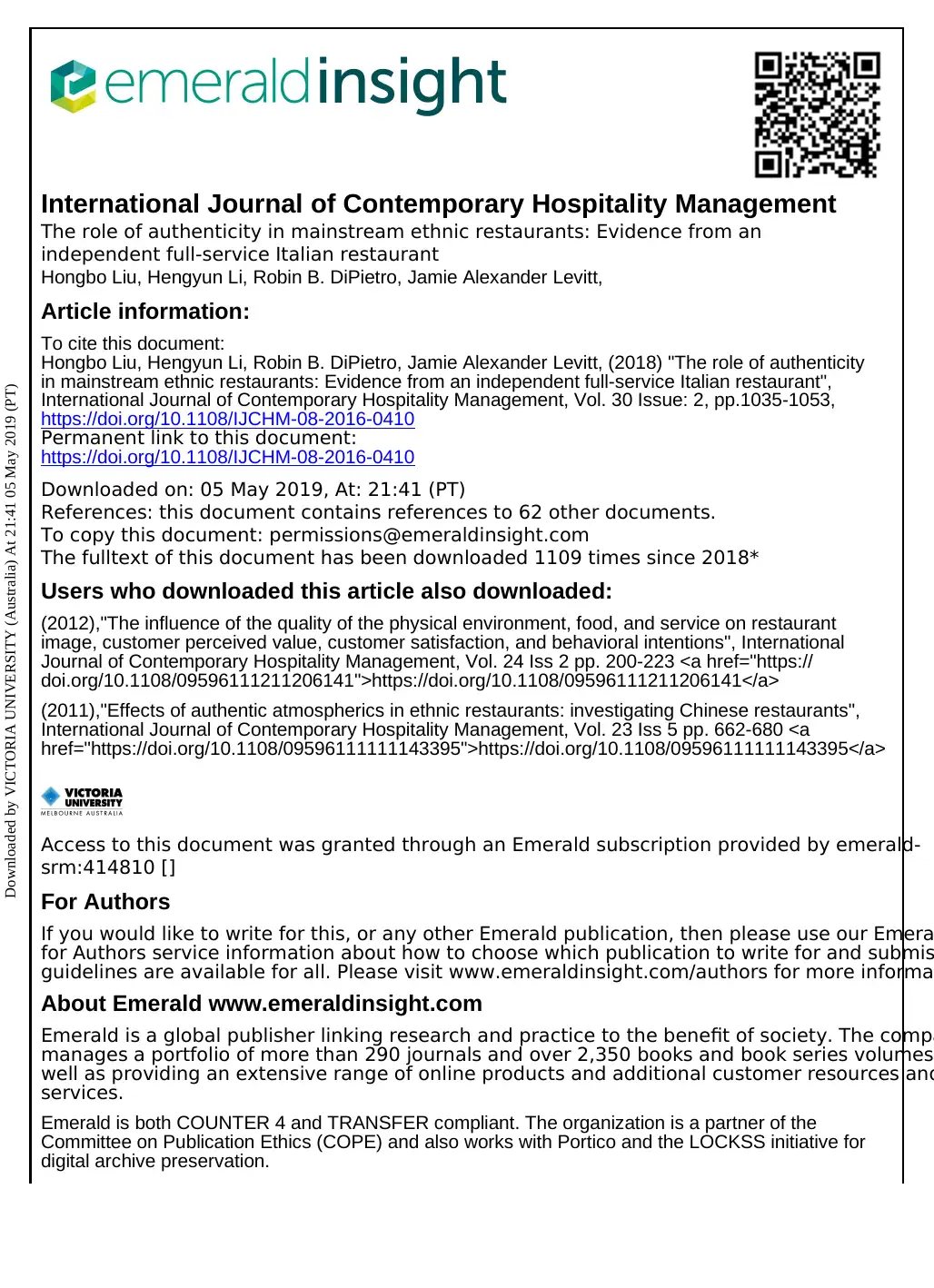
International Journal of Contemporary Hospitality Management
The role of authenticity in mainstream ethnic restaurants: Evidence from an
independent full-service Italian restaurant
Hongbo Liu, Hengyun Li, Robin B. DiPietro, Jamie Alexander Levitt,
Article information:
To cite this document:
Hongbo Liu, Hengyun Li, Robin B. DiPietro, Jamie Alexander Levitt, (2018) "The role of authenticity
in mainstream ethnic restaurants: Evidence from an independent full-service Italian restaurant",
International Journal of Contemporary Hospitality Management, Vol. 30 Issue: 2, pp.1035-1053,
https://doi.org/10.1108/IJCHM-08-2016-0410
Permanent link to this document:
https://doi.org/10.1108/IJCHM-08-2016-0410
Downloaded on: 05 May 2019, At: 21:41 (PT)
References: this document contains references to 62 other documents.
To copy this document: permissions@emeraldinsight.com
The fulltext of this document has been downloaded 1109 times since 2018*
Users who downloaded this article also downloaded:
(2012),"The influence of the quality of the physical environment, food, and service on restaurant
image, customer perceived value, customer satisfaction, and behavioral intentions", International
Journal of Contemporary Hospitality Management, Vol. 24 Iss 2 pp. 200-223 <a href="https://
doi.org/10.1108/09596111211206141">https://doi.org/10.1108/09596111211206141</a>
(2011),"Effects of authentic atmospherics in ethnic restaurants: investigating Chinese restaurants",
International Journal of Contemporary Hospitality Management, Vol. 23 Iss 5 pp. 662-680 <a
href="https://doi.org/10.1108/09596111111143395">https://doi.org/10.1108/09596111111143395</a>
Access to this document was granted through an Emerald subscription provided by emerald-
srm:414810 []
For Authors
If you would like to write for this, or any other Emerald publication, then please use our Emera
for Authors service information about how to choose which publication to write for and submis
guidelines are available for all. Please visit www.emeraldinsight.com/authors for more informa
About Emerald www.emeraldinsight.com
Emerald is a global publisher linking research and practice to the benefit of society. The compa
manages a portfolio of more than 290 journals and over 2,350 books and book series volumes
well as providing an extensive range of online products and additional customer resources and
services.
Emerald is both COUNTER 4 and TRANSFER compliant. The organization is a partner of the
Committee on Publication Ethics (COPE) and also works with Portico and the LOCKSS initiative for
digital archive preservation.
Downloaded by VICTORIA UNIVERSITY (Australia) At 21:41 05 May 2019 (PT)
The role of authenticity in mainstream ethnic restaurants: Evidence from an
independent full-service Italian restaurant
Hongbo Liu, Hengyun Li, Robin B. DiPietro, Jamie Alexander Levitt,
Article information:
To cite this document:
Hongbo Liu, Hengyun Li, Robin B. DiPietro, Jamie Alexander Levitt, (2018) "The role of authenticity
in mainstream ethnic restaurants: Evidence from an independent full-service Italian restaurant",
International Journal of Contemporary Hospitality Management, Vol. 30 Issue: 2, pp.1035-1053,
https://doi.org/10.1108/IJCHM-08-2016-0410
Permanent link to this document:
https://doi.org/10.1108/IJCHM-08-2016-0410
Downloaded on: 05 May 2019, At: 21:41 (PT)
References: this document contains references to 62 other documents.
To copy this document: permissions@emeraldinsight.com
The fulltext of this document has been downloaded 1109 times since 2018*
Users who downloaded this article also downloaded:
(2012),"The influence of the quality of the physical environment, food, and service on restaurant
image, customer perceived value, customer satisfaction, and behavioral intentions", International
Journal of Contemporary Hospitality Management, Vol. 24 Iss 2 pp. 200-223 <a href="https://
doi.org/10.1108/09596111211206141">https://doi.org/10.1108/09596111211206141</a>
(2011),"Effects of authentic atmospherics in ethnic restaurants: investigating Chinese restaurants",
International Journal of Contemporary Hospitality Management, Vol. 23 Iss 5 pp. 662-680 <a
href="https://doi.org/10.1108/09596111111143395">https://doi.org/10.1108/09596111111143395</a>
Access to this document was granted through an Emerald subscription provided by emerald-
srm:414810 []
For Authors
If you would like to write for this, or any other Emerald publication, then please use our Emera
for Authors service information about how to choose which publication to write for and submis
guidelines are available for all. Please visit www.emeraldinsight.com/authors for more informa
About Emerald www.emeraldinsight.com
Emerald is a global publisher linking research and practice to the benefit of society. The compa
manages a portfolio of more than 290 journals and over 2,350 books and book series volumes
well as providing an extensive range of online products and additional customer resources and
services.
Emerald is both COUNTER 4 and TRANSFER compliant. The organization is a partner of the
Committee on Publication Ethics (COPE) and also works with Portico and the LOCKSS initiative for
digital archive preservation.
Downloaded by VICTORIA UNIVERSITY (Australia) At 21:41 05 May 2019 (PT)
Paraphrase This Document
Need a fresh take? Get an instant paraphrase of this document with our AI Paraphraser

*Related content and download information correct at time of download.
Downloaded by VICTORIA UNIVERSITY (Australia) At 21:41 05 May 2019 (PT)
Downloaded by VICTORIA UNIVERSITY (Australia) At 21:41 05 May 2019 (PT)
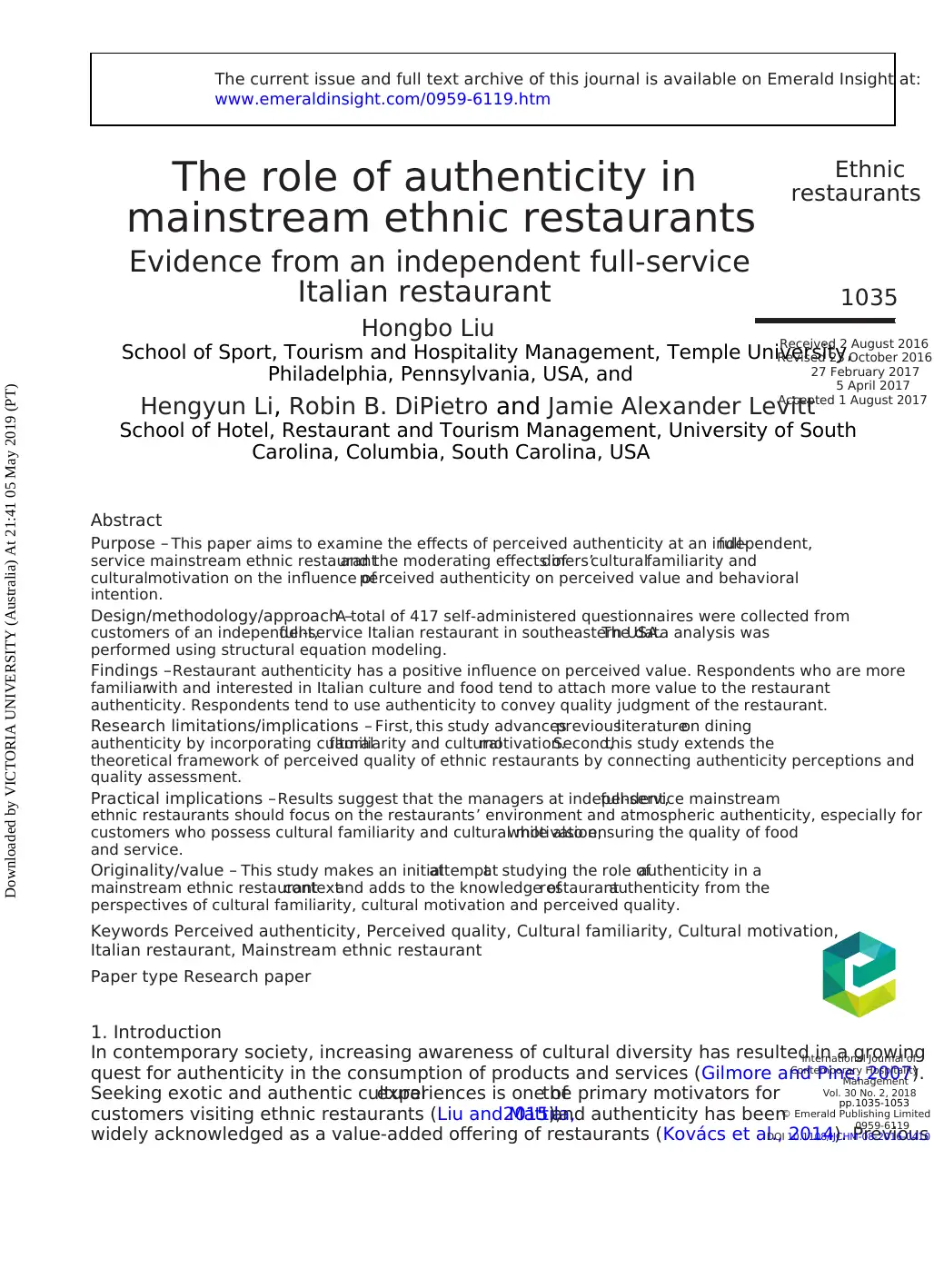
The role of authenticity in
mainstream ethnic restaurants
Evidence from an independent full-service
Italian restaurant
Hongbo Liu
School of Sport, Tourism and Hospitality Management, Temple University,
Philadelphia, Pennsylvania, USA, and
Hengyun Li, Robin B. DiPietro and Jamie Alexander Levitt
School of Hotel, Restaurant and Tourism Management, University of South
Carolina, Columbia, South Carolina, USA
Abstract
Purpose – This paper aims to examine the effects of perceived authenticity at an independent,full-
service mainstream ethnic restaurantand the moderating effects ofdiners’culturalfamiliarity and
culturalmotivation on the influence ofperceived authenticity on perceived value and behavioral
intention.
Design/methodology/approach –A total of 417 self-administered questionnaires were collected from
customers of an independent,full-service Italian restaurant in southeastern USA.The data analysis was
performed using structural equation modeling.
Findings –Restaurant authenticity has a positive influence on perceived value. Respondents who are more
familiarwith and interested in Italian culture and food tend to attach more value to the restaurant
authenticity. Respondents tend to use authenticity to convey quality judgment of the restaurant.
Research limitations/implications – First, this study advancespreviousliteratureon dining
authenticity by incorporating culturalfamiliarity and culturalmotivation.Second,this study extends the
theoretical framework of perceived quality of ethnic restaurants by connecting authenticity perceptions and
quality assessment.
Practical implications –Results suggest that the managers at independent,full-service mainstream
ethnic restaurants should focus on the restaurants’ environment and atmospheric authenticity, especially for
customers who possess cultural familiarity and cultural motivation,while also ensuring the quality of food
and service.
Originality/value – This study makes an initialattemptat studying the role ofauthenticity in a
mainstream ethnic restaurantcontextand adds to the knowledge ofrestaurantauthenticity from the
perspectives of cultural familiarity, cultural motivation and perceived quality.
Keywords Perceived authenticity, Perceived quality, Cultural familiarity, Cultural motivation,
Italian restaurant, Mainstream ethnic restaurant
Paper type Research paper
1. Introduction
In contemporary society, increasing awareness of cultural diversity has resulted in a growing
quest for authenticity in the consumption of products and services (Gilmore and Pine, 2007).
Seeking exotic and authentic culturalexperiences is one ofthe primary motivators for
customers visiting ethnic restaurants (Liu and Mattila,2015),and authenticity has been
widely acknowledged as a value-added offering of restaurants (Kovács et al., 2014). Previous
Ethnic
restaurants
1035
Received 2 August 2016
Revised 23 October 2016
27 February 2017
5 April 2017
Accepted 1 August 2017
International Journal of
Contemporary Hospitality
Management
Vol. 30 No. 2, 2018
pp.1035-1053
© Emerald Publishing Limited
0959-6119
DOI 10.1108/IJCHM-08-2016-0410
The current issue and full text archive of this journal is available on Emerald Insight at:
www.emeraldinsight.com/0959-6119.htm
Downloaded by VICTORIA UNIVERSITY (Australia) At 21:41 05 May 2019 (PT)
mainstream ethnic restaurants
Evidence from an independent full-service
Italian restaurant
Hongbo Liu
School of Sport, Tourism and Hospitality Management, Temple University,
Philadelphia, Pennsylvania, USA, and
Hengyun Li, Robin B. DiPietro and Jamie Alexander Levitt
School of Hotel, Restaurant and Tourism Management, University of South
Carolina, Columbia, South Carolina, USA
Abstract
Purpose – This paper aims to examine the effects of perceived authenticity at an independent,full-
service mainstream ethnic restaurantand the moderating effects ofdiners’culturalfamiliarity and
culturalmotivation on the influence ofperceived authenticity on perceived value and behavioral
intention.
Design/methodology/approach –A total of 417 self-administered questionnaires were collected from
customers of an independent,full-service Italian restaurant in southeastern USA.The data analysis was
performed using structural equation modeling.
Findings –Restaurant authenticity has a positive influence on perceived value. Respondents who are more
familiarwith and interested in Italian culture and food tend to attach more value to the restaurant
authenticity. Respondents tend to use authenticity to convey quality judgment of the restaurant.
Research limitations/implications – First, this study advancespreviousliteratureon dining
authenticity by incorporating culturalfamiliarity and culturalmotivation.Second,this study extends the
theoretical framework of perceived quality of ethnic restaurants by connecting authenticity perceptions and
quality assessment.
Practical implications –Results suggest that the managers at independent,full-service mainstream
ethnic restaurants should focus on the restaurants’ environment and atmospheric authenticity, especially for
customers who possess cultural familiarity and cultural motivation,while also ensuring the quality of food
and service.
Originality/value – This study makes an initialattemptat studying the role ofauthenticity in a
mainstream ethnic restaurantcontextand adds to the knowledge ofrestaurantauthenticity from the
perspectives of cultural familiarity, cultural motivation and perceived quality.
Keywords Perceived authenticity, Perceived quality, Cultural familiarity, Cultural motivation,
Italian restaurant, Mainstream ethnic restaurant
Paper type Research paper
1. Introduction
In contemporary society, increasing awareness of cultural diversity has resulted in a growing
quest for authenticity in the consumption of products and services (Gilmore and Pine, 2007).
Seeking exotic and authentic culturalexperiences is one ofthe primary motivators for
customers visiting ethnic restaurants (Liu and Mattila,2015),and authenticity has been
widely acknowledged as a value-added offering of restaurants (Kovács et al., 2014). Previous
Ethnic
restaurants
1035
Received 2 August 2016
Revised 23 October 2016
27 February 2017
5 April 2017
Accepted 1 August 2017
International Journal of
Contemporary Hospitality
Management
Vol. 30 No. 2, 2018
pp.1035-1053
© Emerald Publishing Limited
0959-6119
DOI 10.1108/IJCHM-08-2016-0410
The current issue and full text archive of this journal is available on Emerald Insight at:
www.emeraldinsight.com/0959-6119.htm
Downloaded by VICTORIA UNIVERSITY (Australia) At 21:41 05 May 2019 (PT)
⊘ This is a preview!⊘
Do you want full access?
Subscribe today to unlock all pages.

Trusted by 1+ million students worldwide
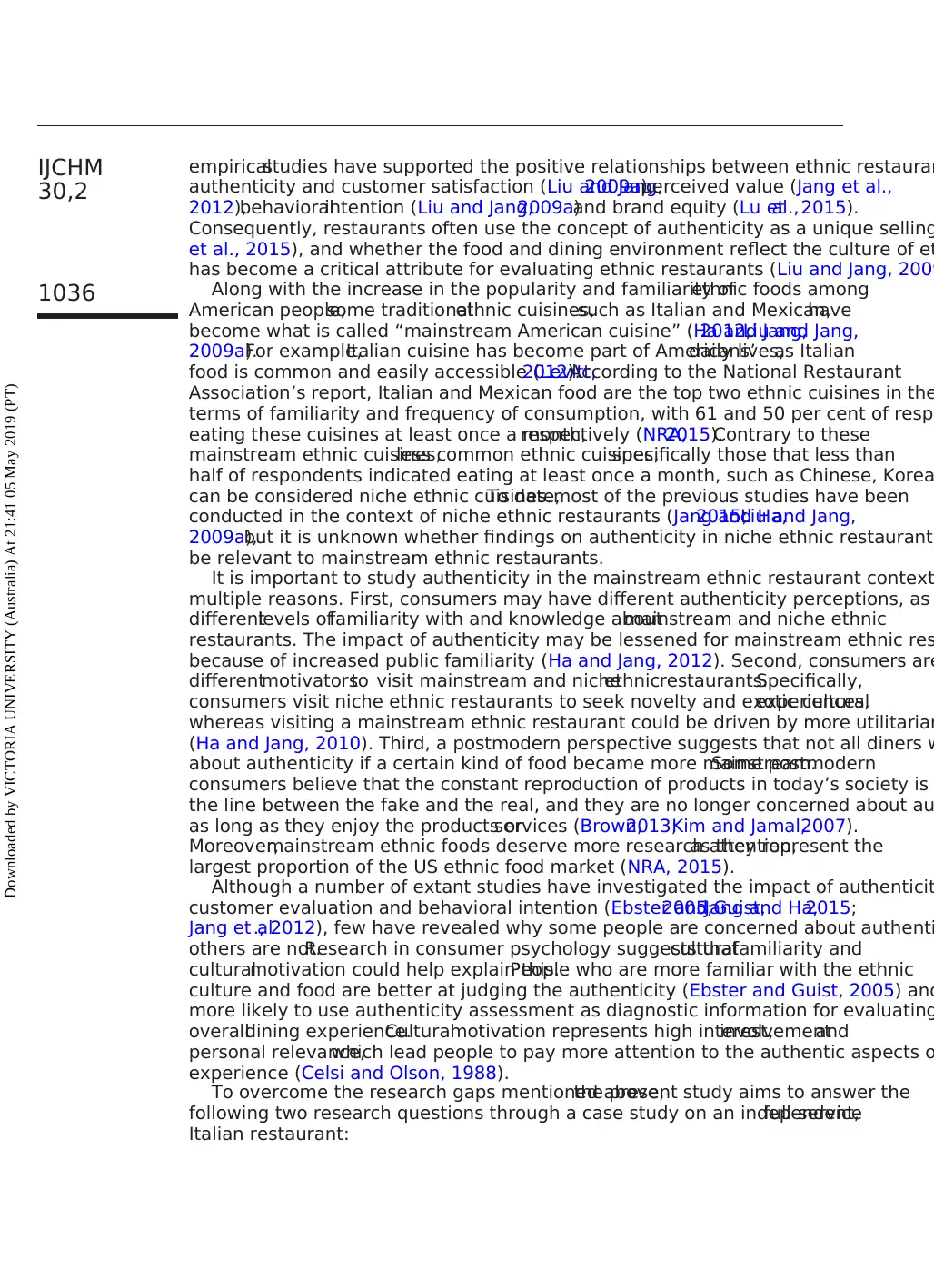
empiricalstudies have supported the positive relationships between ethnic restauran
authenticity and customer satisfaction (Liu and Jang,2009a),perceived value (Jang et al.,
2012),behavioralintention (Liu and Jang,2009a)and brand equity (Lu etal., 2015).
Consequently, restaurants often use the concept of authenticity as a unique selling
et al., 2015), and whether the food and dining environment reflect the culture of et
has become a critical attribute for evaluating ethnic restaurants (Liu and Jang, 2009
Along with the increase in the popularity and familiarity ofethnic foods among
American people,some traditionalethnic cuisines,such as Italian and Mexican,have
become what is called “mainstream American cuisine” (Ha and Jang,2012;Liu and Jang,
2009a).For example,Italian cuisine has become part of Americans’daily lives,as Italian
food is common and easily accessible (Levitt,2012).According to the National Restaurant
Association’s report, Italian and Mexican food are the top two ethnic cuisines in the
terms of familiarity and frequency of consumption, with 61 and 50 per cent of respo
eating these cuisines at least once a month,respectively (NRA,2015).Contrary to these
mainstream ethnic cuisines,less common ethnic cuisines,specifically those that less than
half of respondents indicated eating at least once a month, such as Chinese, Korea
can be considered niche ethnic cuisines.To date,most of the previous studies have been
conducted in the context of niche ethnic restaurants (Jang and Ha,2015;Liu and Jang,
2009a),but it is unknown whether findings on authenticity in niche ethnic restaurants
be relevant to mainstream ethnic restaurants.
It is important to study authenticity in the mainstream ethnic restaurant context
multiple reasons. First, consumers may have different authenticity perceptions, as
differentlevels offamiliarity with and knowledge aboutmainstream and niche ethnic
restaurants. The impact of authenticity may be lessened for mainstream ethnic res
because of increased public familiarity (Ha and Jang, 2012). Second, consumers are
differentmotivatorsto visit mainstream and nicheethnicrestaurants.Specifically,
consumers visit niche ethnic restaurants to seek novelty and exotic culturalexperiences,
whereas visiting a mainstream ethnic restaurant could be driven by more utilitarian
(Ha and Jang, 2010). Third, a postmodern perspective suggests that not all diners w
about authenticity if a certain kind of food became more mainstream.Some postmodern
consumers believe that the constant reproduction of products in today’s society is
the line between the fake and the real, and they are no longer concerned about au
as long as they enjoy the products orservices (Brown,2013;Kim and Jamal,2007).
Moreover,mainstream ethnic foods deserve more research attention,as they represent the
largest proportion of the US ethnic food market (NRA, 2015).
Although a number of extant studies have investigated the impact of authenticit
customer evaluation and behavioral intention (Ebster and Guist,2005;Jang and Ha,2015;
Jang et al., 2012), few have revealed why some people are concerned about authenti
others are not.Research in consumer psychology suggests thatculturalfamiliarity and
culturalmotivation could help explain this.People who are more familiar with the ethnic
culture and food are better at judging the authenticity (Ebster and Guist, 2005) and
more likely to use authenticity assessment as diagnostic information for evaluating
overalldining experience.Culturalmotivation represents high interest,involvementand
personal relevance,which lead people to pay more attention to the authentic aspects o
experience (Celsi and Olson, 1988).
To overcome the research gaps mentioned above,the present study aims to answer the
following two research questions through a case study on an independent,full-service
Italian restaurant:
IJCHM
30,2
1036
Downloaded by VICTORIA UNIVERSITY (Australia) At 21:41 05 May 2019 (PT)
authenticity and customer satisfaction (Liu and Jang,2009a),perceived value (Jang et al.,
2012),behavioralintention (Liu and Jang,2009a)and brand equity (Lu etal., 2015).
Consequently, restaurants often use the concept of authenticity as a unique selling
et al., 2015), and whether the food and dining environment reflect the culture of et
has become a critical attribute for evaluating ethnic restaurants (Liu and Jang, 2009
Along with the increase in the popularity and familiarity ofethnic foods among
American people,some traditionalethnic cuisines,such as Italian and Mexican,have
become what is called “mainstream American cuisine” (Ha and Jang,2012;Liu and Jang,
2009a).For example,Italian cuisine has become part of Americans’daily lives,as Italian
food is common and easily accessible (Levitt,2012).According to the National Restaurant
Association’s report, Italian and Mexican food are the top two ethnic cuisines in the
terms of familiarity and frequency of consumption, with 61 and 50 per cent of respo
eating these cuisines at least once a month,respectively (NRA,2015).Contrary to these
mainstream ethnic cuisines,less common ethnic cuisines,specifically those that less than
half of respondents indicated eating at least once a month, such as Chinese, Korea
can be considered niche ethnic cuisines.To date,most of the previous studies have been
conducted in the context of niche ethnic restaurants (Jang and Ha,2015;Liu and Jang,
2009a),but it is unknown whether findings on authenticity in niche ethnic restaurants
be relevant to mainstream ethnic restaurants.
It is important to study authenticity in the mainstream ethnic restaurant context
multiple reasons. First, consumers may have different authenticity perceptions, as
differentlevels offamiliarity with and knowledge aboutmainstream and niche ethnic
restaurants. The impact of authenticity may be lessened for mainstream ethnic res
because of increased public familiarity (Ha and Jang, 2012). Second, consumers are
differentmotivatorsto visit mainstream and nicheethnicrestaurants.Specifically,
consumers visit niche ethnic restaurants to seek novelty and exotic culturalexperiences,
whereas visiting a mainstream ethnic restaurant could be driven by more utilitarian
(Ha and Jang, 2010). Third, a postmodern perspective suggests that not all diners w
about authenticity if a certain kind of food became more mainstream.Some postmodern
consumers believe that the constant reproduction of products in today’s society is
the line between the fake and the real, and they are no longer concerned about au
as long as they enjoy the products orservices (Brown,2013;Kim and Jamal,2007).
Moreover,mainstream ethnic foods deserve more research attention,as they represent the
largest proportion of the US ethnic food market (NRA, 2015).
Although a number of extant studies have investigated the impact of authenticit
customer evaluation and behavioral intention (Ebster and Guist,2005;Jang and Ha,2015;
Jang et al., 2012), few have revealed why some people are concerned about authenti
others are not.Research in consumer psychology suggests thatculturalfamiliarity and
culturalmotivation could help explain this.People who are more familiar with the ethnic
culture and food are better at judging the authenticity (Ebster and Guist, 2005) and
more likely to use authenticity assessment as diagnostic information for evaluating
overalldining experience.Culturalmotivation represents high interest,involvementand
personal relevance,which lead people to pay more attention to the authentic aspects o
experience (Celsi and Olson, 1988).
To overcome the research gaps mentioned above,the present study aims to answer the
following two research questions through a case study on an independent,full-service
Italian restaurant:
IJCHM
30,2
1036
Downloaded by VICTORIA UNIVERSITY (Australia) At 21:41 05 May 2019 (PT)
Paraphrase This Document
Need a fresh take? Get an instant paraphrase of this document with our AI Paraphraser
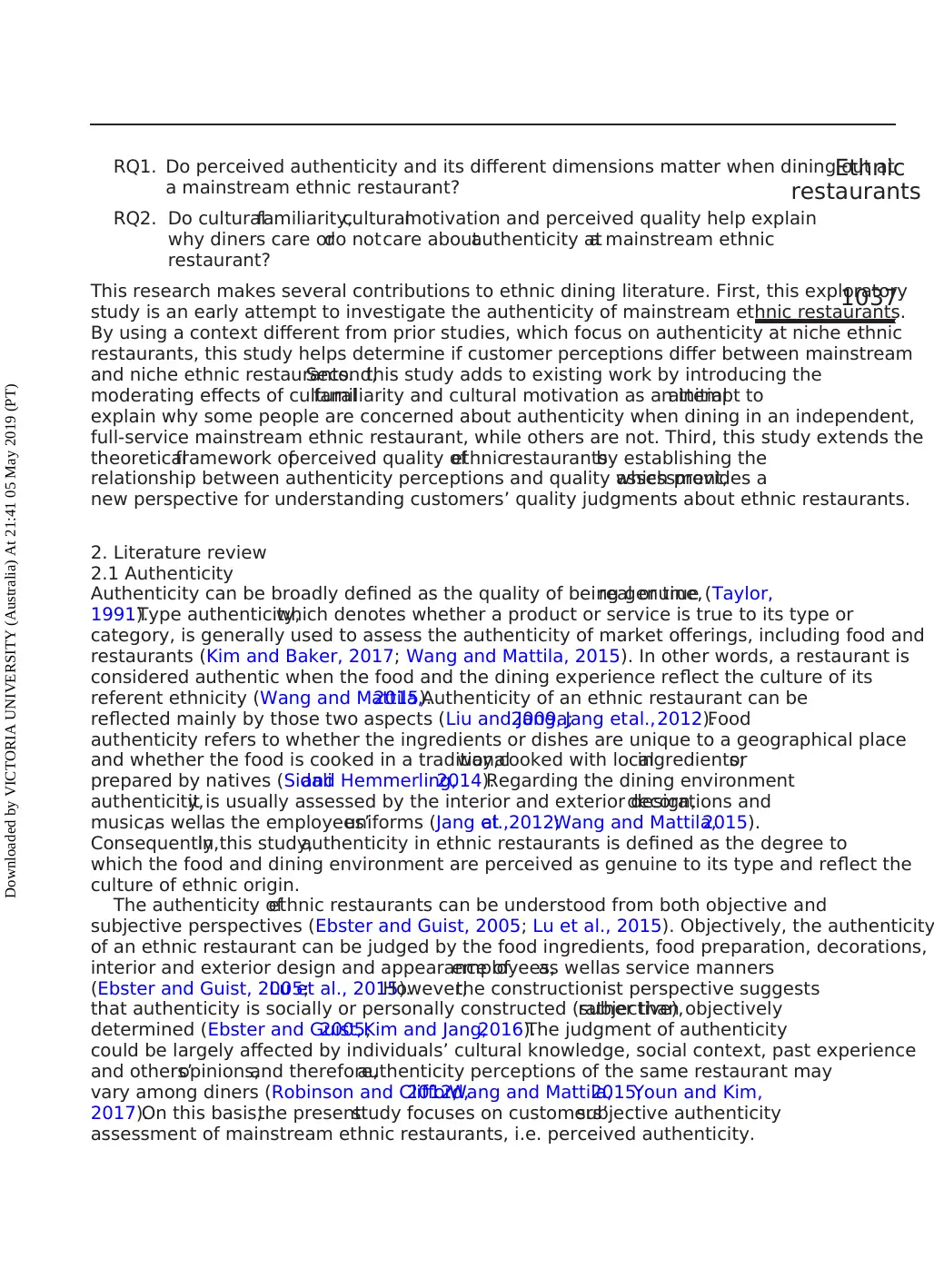
RQ1. Do perceived authenticity and its different dimensions matter when dining out at
a mainstream ethnic restaurant?
RQ2. Do culturalfamiliarity,culturalmotivation and perceived quality help explain
why diners care ordo notcare aboutauthenticity ata mainstream ethnic
restaurant?
This research makes several contributions to ethnic dining literature. First, this exploratory
study is an early attempt to investigate the authenticity of mainstream ethnic restaurants.
By using a context different from prior studies, which focus on authenticity at niche ethnic
restaurants, this study helps determine if customer perceptions differ between mainstream
and niche ethnic restaurants.Second,this study adds to existing work by introducing the
moderating effects of culturalfamiliarity and cultural motivation as an initialattempt to
explain why some people are concerned about authenticity when dining in an independent,
full-service mainstream ethnic restaurant, while others are not. Third, this study extends the
theoreticalframework ofperceived quality ofethnicrestaurantsby establishing the
relationship between authenticity perceptions and quality assessment,which provides a
new perspective for understanding customers’ quality judgments about ethnic restaurants.
2. Literature review
2.1 Authenticity
Authenticity can be broadly defined as the quality of being genuine,real or true (Taylor,
1991).Type authenticity,which denotes whether a product or service is true to its type or
category, is generally used to assess the authenticity of market offerings, including food and
restaurants (Kim and Baker, 2017; Wang and Mattila, 2015). In other words, a restaurant is
considered authentic when the food and the dining experience reflect the culture of its
referent ethnicity (Wang and Mattila,2015).Authenticity of an ethnic restaurant can be
reflected mainly by those two aspects (Liu and Jang,2009a;Jang etal.,2012).Food
authenticity refers to whether the ingredients or dishes are unique to a geographical place
and whether the food is cooked in a traditionalway;cooked with localingredients;or
prepared by natives (Sidaliand Hemmerling,2014).Regarding the dining environment
authenticity,it is usually assessed by the interior and exterior design,decorations and
music,as wellas the employees’uniforms (Jang etal.,2012;Wang and Mattila,2015).
Consequently,in this study,authenticity in ethnic restaurants is defined as the degree to
which the food and dining environment are perceived as genuine to its type and reflect the
culture of ethnic origin.
The authenticity ofethnic restaurants can be understood from both objective and
subjective perspectives (Ebster and Guist, 2005; Lu et al., 2015). Objectively, the authenticity
of an ethnic restaurant can be judged by the food ingredients, food preparation, decorations,
interior and exterior design and appearance ofemployees,as wellas service manners
(Ebster and Guist, 2005;Lu et al., 2015).However,the constructionist perspective suggests
that authenticity is socially or personally constructed (subjective),rather than objectively
determined (Ebster and Guist,2005;Kim and Jang,2016).The judgment of authenticity
could be largely affected by individuals’ cultural knowledge, social context, past experience
and others’opinions,and therefore,authenticity perceptions of the same restaurant may
vary among diners (Robinson and Clifford,2012;Wang and Mattila,2015;Youn and Kim,
2017).On this basis,the presentstudy focuses on customers’subjective authenticity
assessment of mainstream ethnic restaurants, i.e. perceived authenticity.
Ethnic
restaurants
1037
Downloaded by VICTORIA UNIVERSITY (Australia) At 21:41 05 May 2019 (PT)
a mainstream ethnic restaurant?
RQ2. Do culturalfamiliarity,culturalmotivation and perceived quality help explain
why diners care ordo notcare aboutauthenticity ata mainstream ethnic
restaurant?
This research makes several contributions to ethnic dining literature. First, this exploratory
study is an early attempt to investigate the authenticity of mainstream ethnic restaurants.
By using a context different from prior studies, which focus on authenticity at niche ethnic
restaurants, this study helps determine if customer perceptions differ between mainstream
and niche ethnic restaurants.Second,this study adds to existing work by introducing the
moderating effects of culturalfamiliarity and cultural motivation as an initialattempt to
explain why some people are concerned about authenticity when dining in an independent,
full-service mainstream ethnic restaurant, while others are not. Third, this study extends the
theoreticalframework ofperceived quality ofethnicrestaurantsby establishing the
relationship between authenticity perceptions and quality assessment,which provides a
new perspective for understanding customers’ quality judgments about ethnic restaurants.
2. Literature review
2.1 Authenticity
Authenticity can be broadly defined as the quality of being genuine,real or true (Taylor,
1991).Type authenticity,which denotes whether a product or service is true to its type or
category, is generally used to assess the authenticity of market offerings, including food and
restaurants (Kim and Baker, 2017; Wang and Mattila, 2015). In other words, a restaurant is
considered authentic when the food and the dining experience reflect the culture of its
referent ethnicity (Wang and Mattila,2015).Authenticity of an ethnic restaurant can be
reflected mainly by those two aspects (Liu and Jang,2009a;Jang etal.,2012).Food
authenticity refers to whether the ingredients or dishes are unique to a geographical place
and whether the food is cooked in a traditionalway;cooked with localingredients;or
prepared by natives (Sidaliand Hemmerling,2014).Regarding the dining environment
authenticity,it is usually assessed by the interior and exterior design,decorations and
music,as wellas the employees’uniforms (Jang etal.,2012;Wang and Mattila,2015).
Consequently,in this study,authenticity in ethnic restaurants is defined as the degree to
which the food and dining environment are perceived as genuine to its type and reflect the
culture of ethnic origin.
The authenticity ofethnic restaurants can be understood from both objective and
subjective perspectives (Ebster and Guist, 2005; Lu et al., 2015). Objectively, the authenticity
of an ethnic restaurant can be judged by the food ingredients, food preparation, decorations,
interior and exterior design and appearance ofemployees,as wellas service manners
(Ebster and Guist, 2005;Lu et al., 2015).However,the constructionist perspective suggests
that authenticity is socially or personally constructed (subjective),rather than objectively
determined (Ebster and Guist,2005;Kim and Jang,2016).The judgment of authenticity
could be largely affected by individuals’ cultural knowledge, social context, past experience
and others’opinions,and therefore,authenticity perceptions of the same restaurant may
vary among diners (Robinson and Clifford,2012;Wang and Mattila,2015;Youn and Kim,
2017).On this basis,the presentstudy focuses on customers’subjective authenticity
assessment of mainstream ethnic restaurants, i.e. perceived authenticity.
Ethnic
restaurants
1037
Downloaded by VICTORIA UNIVERSITY (Australia) At 21:41 05 May 2019 (PT)
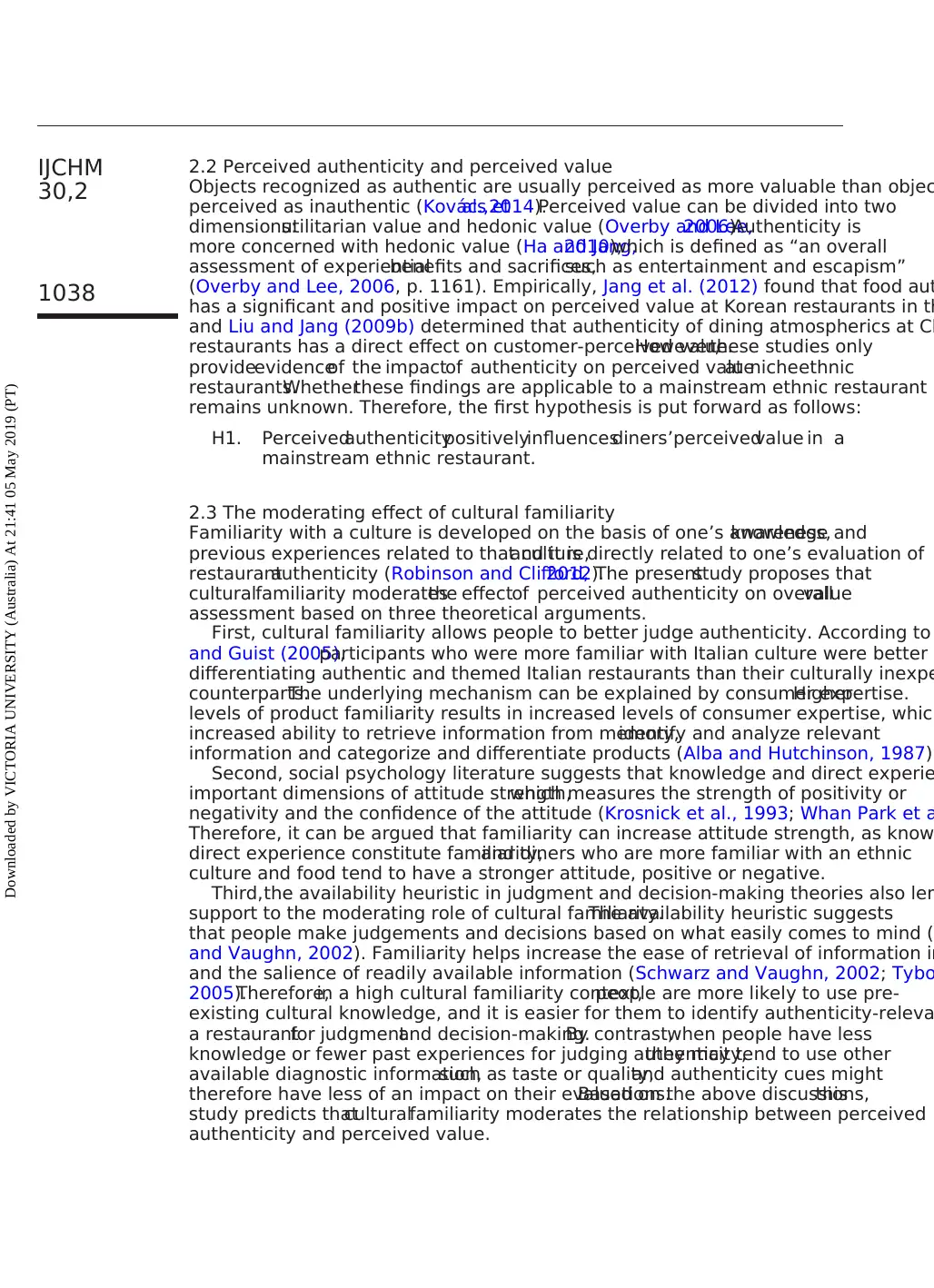
2.2 Perceived authenticity and perceived value
Objects recognized as authentic are usually perceived as more valuable than objec
perceived as inauthentic (Kovács etal.,2014).Perceived value can be divided into two
dimensions:utilitarian value and hedonic value (Overby and Lee,2006).Authenticity is
more concerned with hedonic value (Ha and Jang,2010),which is defined as “an overall
assessment of experientialbenefits and sacrifices,such as entertainment and escapism”
(Overby and Lee, 2006, p. 1161). Empirically, Jang et al. (2012) found that food aut
has a significant and positive impact on perceived value at Korean restaurants in th
and Liu and Jang (2009b) determined that authenticity of dining atmospherics at Ch
restaurants has a direct effect on customer-perceived value.However,these studies only
provideevidenceof the impactof authenticity on perceived valueat nicheethnic
restaurants.Whetherthese findings are applicable to a mainstream ethnic restaurant
remains unknown. Therefore, the first hypothesis is put forward as follows:
H1. Perceivedauthenticitypositivelyinfluencesdiners’perceivedvalue in a
mainstream ethnic restaurant.
2.3 The moderating effect of cultural familiarity
Familiarity with a culture is developed on the basis of one’s awareness,knowledge and
previous experiences related to that culture,and it is directly related to one’s evaluation of
restaurantauthenticity (Robinson and Clifford,2012).The presentstudy proposes that
culturalfamiliarity moderatesthe effectof perceived authenticity on overallvalue
assessment based on three theoretical arguments.
First, cultural familiarity allows people to better judge authenticity. According to
and Guist (2005),participants who were more familiar with Italian culture were better a
differentiating authentic and themed Italian restaurants than their culturally inexpe
counterparts.The underlying mechanism can be explained by consumer expertise.Higher
levels of product familiarity results in increased levels of consumer expertise, which
increased ability to retrieve information from memory,identify and analyze relevant
information and categorize and differentiate products (Alba and Hutchinson, 1987).
Second, social psychology literature suggests that knowledge and direct experie
important dimensions of attitude strength,which measures the strength of positivity or
negativity and the confidence of the attitude (Krosnick et al., 1993; Whan Park et a
Therefore, it can be argued that familiarity can increase attitude strength, as know
direct experience constitute familiarity,and diners who are more familiar with an ethnic
culture and food tend to have a stronger attitude, positive or negative.
Third,the availability heuristic in judgment and decision-making theories also len
support to the moderating role of cultural familiarity.The availability heuristic suggests
that people make judgements and decisions based on what easily comes to mind (
and Vaughn, 2002). Familiarity helps increase the ease of retrieval of information in
and the salience of readily available information (Schwarz and Vaughn, 2002; Tybo
2005).Therefore,in a high cultural familiarity context,people are more likely to use pre-
existing cultural knowledge, and it is easier for them to identify authenticity-releva
a restaurantfor judgmentand decision-making.By contrast,when people have less
knowledge or fewer past experiences for judging authenticity,they may tend to use other
available diagnostic information,such as taste or quality,and authenticity cues might
therefore have less of an impact on their evaluations.Based on the above discussions,this
study predicts thatculturalfamiliarity moderates the relationship between perceived
authenticity and perceived value.
IJCHM
30,2
1038
Downloaded by VICTORIA UNIVERSITY (Australia) At 21:41 05 May 2019 (PT)
Objects recognized as authentic are usually perceived as more valuable than objec
perceived as inauthentic (Kovács etal.,2014).Perceived value can be divided into two
dimensions:utilitarian value and hedonic value (Overby and Lee,2006).Authenticity is
more concerned with hedonic value (Ha and Jang,2010),which is defined as “an overall
assessment of experientialbenefits and sacrifices,such as entertainment and escapism”
(Overby and Lee, 2006, p. 1161). Empirically, Jang et al. (2012) found that food aut
has a significant and positive impact on perceived value at Korean restaurants in th
and Liu and Jang (2009b) determined that authenticity of dining atmospherics at Ch
restaurants has a direct effect on customer-perceived value.However,these studies only
provideevidenceof the impactof authenticity on perceived valueat nicheethnic
restaurants.Whetherthese findings are applicable to a mainstream ethnic restaurant
remains unknown. Therefore, the first hypothesis is put forward as follows:
H1. Perceivedauthenticitypositivelyinfluencesdiners’perceivedvalue in a
mainstream ethnic restaurant.
2.3 The moderating effect of cultural familiarity
Familiarity with a culture is developed on the basis of one’s awareness,knowledge and
previous experiences related to that culture,and it is directly related to one’s evaluation of
restaurantauthenticity (Robinson and Clifford,2012).The presentstudy proposes that
culturalfamiliarity moderatesthe effectof perceived authenticity on overallvalue
assessment based on three theoretical arguments.
First, cultural familiarity allows people to better judge authenticity. According to
and Guist (2005),participants who were more familiar with Italian culture were better a
differentiating authentic and themed Italian restaurants than their culturally inexpe
counterparts.The underlying mechanism can be explained by consumer expertise.Higher
levels of product familiarity results in increased levels of consumer expertise, which
increased ability to retrieve information from memory,identify and analyze relevant
information and categorize and differentiate products (Alba and Hutchinson, 1987).
Second, social psychology literature suggests that knowledge and direct experie
important dimensions of attitude strength,which measures the strength of positivity or
negativity and the confidence of the attitude (Krosnick et al., 1993; Whan Park et a
Therefore, it can be argued that familiarity can increase attitude strength, as know
direct experience constitute familiarity,and diners who are more familiar with an ethnic
culture and food tend to have a stronger attitude, positive or negative.
Third,the availability heuristic in judgment and decision-making theories also len
support to the moderating role of cultural familiarity.The availability heuristic suggests
that people make judgements and decisions based on what easily comes to mind (
and Vaughn, 2002). Familiarity helps increase the ease of retrieval of information in
and the salience of readily available information (Schwarz and Vaughn, 2002; Tybo
2005).Therefore,in a high cultural familiarity context,people are more likely to use pre-
existing cultural knowledge, and it is easier for them to identify authenticity-releva
a restaurantfor judgmentand decision-making.By contrast,when people have less
knowledge or fewer past experiences for judging authenticity,they may tend to use other
available diagnostic information,such as taste or quality,and authenticity cues might
therefore have less of an impact on their evaluations.Based on the above discussions,this
study predicts thatculturalfamiliarity moderates the relationship between perceived
authenticity and perceived value.
IJCHM
30,2
1038
Downloaded by VICTORIA UNIVERSITY (Australia) At 21:41 05 May 2019 (PT)
⊘ This is a preview!⊘
Do you want full access?
Subscribe today to unlock all pages.

Trusted by 1+ million students worldwide
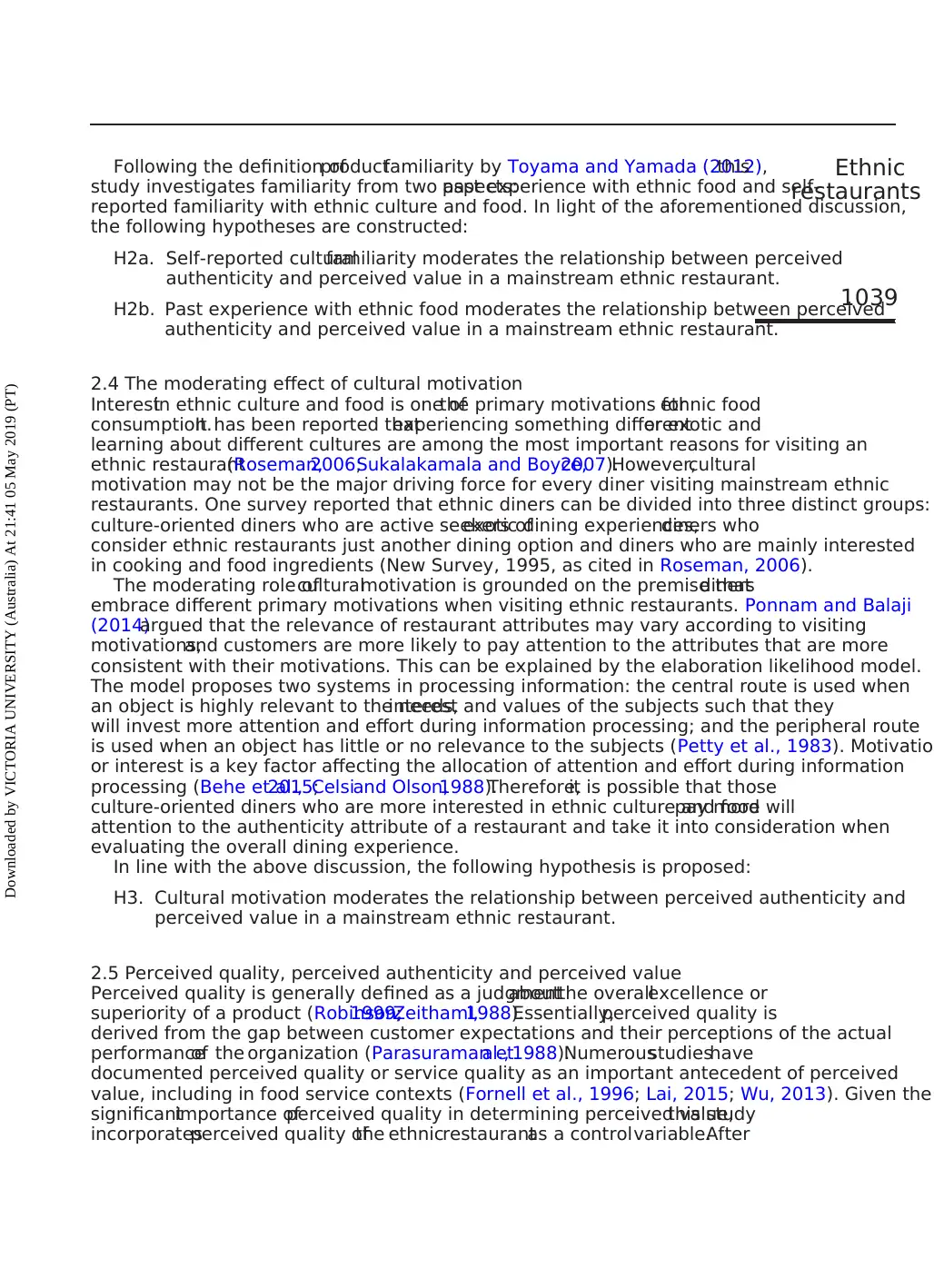
Following the definition ofproductfamiliarity by Toyama and Yamada (2012),this
study investigates familiarity from two aspects:past experience with ethnic food and self-
reported familiarity with ethnic culture and food. In light of the aforementioned discussion,
the following hypotheses are constructed:
H2a. Self-reported culturalfamiliarity moderates the relationship between perceived
authenticity and perceived value in a mainstream ethnic restaurant.
H2b. Past experience with ethnic food moderates the relationship between perceived
authenticity and perceived value in a mainstream ethnic restaurant.
2.4 The moderating effect of cultural motivation
Interestin ethnic culture and food is one ofthe primary motivations forethnic food
consumption.It has been reported thatexperiencing something differentor exotic and
learning about different cultures are among the most important reasons for visiting an
ethnic restaurant(Roseman,2006;Sukalakamala and Boyce,2007).However,cultural
motivation may not be the major driving force for every diner visiting mainstream ethnic
restaurants. One survey reported that ethnic diners can be divided into three distinct groups:
culture-oriented diners who are active seekers ofexotic dining experiences,diners who
consider ethnic restaurants just another dining option and diners who are mainly interested
in cooking and food ingredients (New Survey, 1995, as cited in Roseman, 2006).
The moderating role ofculturalmotivation is grounded on the premise thatdiners
embrace different primary motivations when visiting ethnic restaurants. Ponnam and Balaji
(2014)argued that the relevance of restaurant attributes may vary according to visiting
motivations,and customers are more likely to pay attention to the attributes that are more
consistent with their motivations. This can be explained by the elaboration likelihood model.
The model proposes two systems in processing information: the central route is used when
an object is highly relevant to the needs,interest and values of the subjects such that they
will invest more attention and effort during information processing; and the peripheral route
is used when an object has little or no relevance to the subjects (Petty et al., 1983). Motivation
or interest is a key factor affecting the allocation of attention and effort during information
processing (Behe et al.,2015;Celsiand Olson,1988).Therefore,it is possible that those
culture-oriented diners who are more interested in ethnic culture and food willpay more
attention to the authenticity attribute of a restaurant and take it into consideration when
evaluating the overall dining experience.
In line with the above discussion, the following hypothesis is proposed:
H3. Cultural motivation moderates the relationship between perceived authenticity and
perceived value in a mainstream ethnic restaurant.
2.5 Perceived quality, perceived authenticity and perceived value
Perceived quality is generally defined as a judgmentaboutthe overallexcellence or
superiority of a product (Robinson,1999;Zeithaml,1988).Essentially,perceived quality is
derived from the gap between customer expectations and their perceptions of the actual
performanceof the organization (Parasuraman etal., 1988).Numerousstudieshave
documented perceived quality or service quality as an important antecedent of perceived
value, including in food service contexts (Fornell et al., 1996; Lai, 2015; Wu, 2013). Given the
significantimportance ofperceived quality in determining perceived value,this study
incorporatesperceived quality ofthe ethnicrestaurantas a controlvariable.After
Ethnic
restaurants
1039
Downloaded by VICTORIA UNIVERSITY (Australia) At 21:41 05 May 2019 (PT)
study investigates familiarity from two aspects:past experience with ethnic food and self-
reported familiarity with ethnic culture and food. In light of the aforementioned discussion,
the following hypotheses are constructed:
H2a. Self-reported culturalfamiliarity moderates the relationship between perceived
authenticity and perceived value in a mainstream ethnic restaurant.
H2b. Past experience with ethnic food moderates the relationship between perceived
authenticity and perceived value in a mainstream ethnic restaurant.
2.4 The moderating effect of cultural motivation
Interestin ethnic culture and food is one ofthe primary motivations forethnic food
consumption.It has been reported thatexperiencing something differentor exotic and
learning about different cultures are among the most important reasons for visiting an
ethnic restaurant(Roseman,2006;Sukalakamala and Boyce,2007).However,cultural
motivation may not be the major driving force for every diner visiting mainstream ethnic
restaurants. One survey reported that ethnic diners can be divided into three distinct groups:
culture-oriented diners who are active seekers ofexotic dining experiences,diners who
consider ethnic restaurants just another dining option and diners who are mainly interested
in cooking and food ingredients (New Survey, 1995, as cited in Roseman, 2006).
The moderating role ofculturalmotivation is grounded on the premise thatdiners
embrace different primary motivations when visiting ethnic restaurants. Ponnam and Balaji
(2014)argued that the relevance of restaurant attributes may vary according to visiting
motivations,and customers are more likely to pay attention to the attributes that are more
consistent with their motivations. This can be explained by the elaboration likelihood model.
The model proposes two systems in processing information: the central route is used when
an object is highly relevant to the needs,interest and values of the subjects such that they
will invest more attention and effort during information processing; and the peripheral route
is used when an object has little or no relevance to the subjects (Petty et al., 1983). Motivation
or interest is a key factor affecting the allocation of attention and effort during information
processing (Behe et al.,2015;Celsiand Olson,1988).Therefore,it is possible that those
culture-oriented diners who are more interested in ethnic culture and food willpay more
attention to the authenticity attribute of a restaurant and take it into consideration when
evaluating the overall dining experience.
In line with the above discussion, the following hypothesis is proposed:
H3. Cultural motivation moderates the relationship between perceived authenticity and
perceived value in a mainstream ethnic restaurant.
2.5 Perceived quality, perceived authenticity and perceived value
Perceived quality is generally defined as a judgmentaboutthe overallexcellence or
superiority of a product (Robinson,1999;Zeithaml,1988).Essentially,perceived quality is
derived from the gap between customer expectations and their perceptions of the actual
performanceof the organization (Parasuraman etal., 1988).Numerousstudieshave
documented perceived quality or service quality as an important antecedent of perceived
value, including in food service contexts (Fornell et al., 1996; Lai, 2015; Wu, 2013). Given the
significantimportance ofperceived quality in determining perceived value,this study
incorporatesperceived quality ofthe ethnicrestaurantas a controlvariable.After
Ethnic
restaurants
1039
Downloaded by VICTORIA UNIVERSITY (Australia) At 21:41 05 May 2019 (PT)
Paraphrase This Document
Need a fresh take? Get an instant paraphrase of this document with our AI Paraphraser
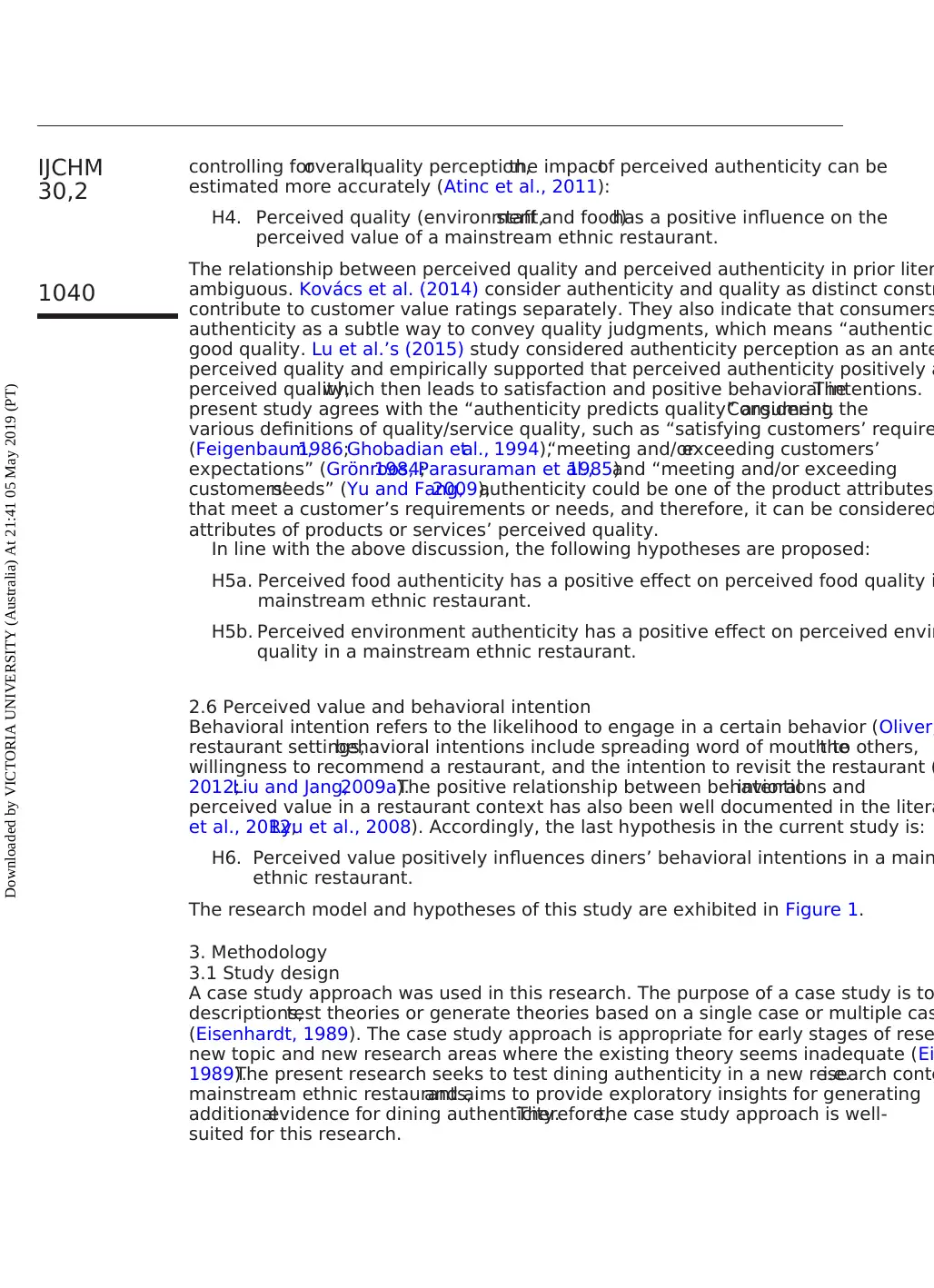
controlling foroverallquality perception,the impactof perceived authenticity can be
estimated more accurately (Atinc et al., 2011):
H4. Perceived quality (environment,staff and food)has a positive influence on the
perceived value of a mainstream ethnic restaurant.
The relationship between perceived quality and perceived authenticity in prior liter
ambiguous. Kovács et al. (2014) consider authenticity and quality as distinct constr
contribute to customer value ratings separately. They also indicate that consumers
authenticity as a subtle way to convey quality judgments, which means “authentic”
good quality. Lu et al.’s (2015) study considered authenticity perception as an ante
perceived quality and empirically supported that perceived authenticity positively a
perceived quality,which then leads to satisfaction and positive behavioral intentions.The
present study agrees with the “authenticity predicts quality” argument.Considering the
various definitions of quality/service quality, such as “satisfying customers’ require
(Feigenbaum,1986;Ghobadian etal., 1994),“meeting and/orexceeding customers’
expectations” (Grönroos,1984;Parasuraman et al.,1985)and “meeting and/or exceeding
customers’needs” (Yu and Fang,2009),authenticity could be one of the product attributes
that meet a customer’s requirements or needs, and therefore, it can be considered
attributes of products or services’ perceived quality.
In line with the above discussion, the following hypotheses are proposed:
H5a. Perceived food authenticity has a positive effect on perceived food quality i
mainstream ethnic restaurant.
H5b. Perceived environment authenticity has a positive effect on perceived envir
quality in a mainstream ethnic restaurant.
2.6 Perceived value and behavioral intention
Behavioral intention refers to the likelihood to engage in a certain behavior (Oliver,
restaurant settings,behavioral intentions include spreading word of mouth to others,the
willingness to recommend a restaurant, and the intention to revisit the restaurant (
2012;Liu and Jang,2009a).The positive relationship between behavioralintentions and
perceived value in a restaurant context has also been well documented in the litera
et al., 2012;Ryu et al., 2008). Accordingly, the last hypothesis in the current study is:
H6. Perceived value positively influences diners’ behavioral intentions in a main
ethnic restaurant.
The research model and hypotheses of this study are exhibited in Figure 1.
3. Methodology
3.1 Study design
A case study approach was used in this research. The purpose of a case study is to
descriptions,test theories or generate theories based on a single case or multiple cas
(Eisenhardt, 1989). The case study approach is appropriate for early stages of rese
new topic and new research areas where the existing theory seems inadequate (Ei
1989).The present research seeks to test dining authenticity in a new research contei.e.
mainstream ethnic restaurants,and aims to provide exploratory insights for generating
additionalevidence for dining authenticity.Therefore,the case study approach is well-
suited for this research.
IJCHM
30,2
1040
Downloaded by VICTORIA UNIVERSITY (Australia) At 21:41 05 May 2019 (PT)
estimated more accurately (Atinc et al., 2011):
H4. Perceived quality (environment,staff and food)has a positive influence on the
perceived value of a mainstream ethnic restaurant.
The relationship between perceived quality and perceived authenticity in prior liter
ambiguous. Kovács et al. (2014) consider authenticity and quality as distinct constr
contribute to customer value ratings separately. They also indicate that consumers
authenticity as a subtle way to convey quality judgments, which means “authentic”
good quality. Lu et al.’s (2015) study considered authenticity perception as an ante
perceived quality and empirically supported that perceived authenticity positively a
perceived quality,which then leads to satisfaction and positive behavioral intentions.The
present study agrees with the “authenticity predicts quality” argument.Considering the
various definitions of quality/service quality, such as “satisfying customers’ require
(Feigenbaum,1986;Ghobadian etal., 1994),“meeting and/orexceeding customers’
expectations” (Grönroos,1984;Parasuraman et al.,1985)and “meeting and/or exceeding
customers’needs” (Yu and Fang,2009),authenticity could be one of the product attributes
that meet a customer’s requirements or needs, and therefore, it can be considered
attributes of products or services’ perceived quality.
In line with the above discussion, the following hypotheses are proposed:
H5a. Perceived food authenticity has a positive effect on perceived food quality i
mainstream ethnic restaurant.
H5b. Perceived environment authenticity has a positive effect on perceived envir
quality in a mainstream ethnic restaurant.
2.6 Perceived value and behavioral intention
Behavioral intention refers to the likelihood to engage in a certain behavior (Oliver,
restaurant settings,behavioral intentions include spreading word of mouth to others,the
willingness to recommend a restaurant, and the intention to revisit the restaurant (
2012;Liu and Jang,2009a).The positive relationship between behavioralintentions and
perceived value in a restaurant context has also been well documented in the litera
et al., 2012;Ryu et al., 2008). Accordingly, the last hypothesis in the current study is:
H6. Perceived value positively influences diners’ behavioral intentions in a main
ethnic restaurant.
The research model and hypotheses of this study are exhibited in Figure 1.
3. Methodology
3.1 Study design
A case study approach was used in this research. The purpose of a case study is to
descriptions,test theories or generate theories based on a single case or multiple cas
(Eisenhardt, 1989). The case study approach is appropriate for early stages of rese
new topic and new research areas where the existing theory seems inadequate (Ei
1989).The present research seeks to test dining authenticity in a new research contei.e.
mainstream ethnic restaurants,and aims to provide exploratory insights for generating
additionalevidence for dining authenticity.Therefore,the case study approach is well-
suited for this research.
IJCHM
30,2
1040
Downloaded by VICTORIA UNIVERSITY (Australia) At 21:41 05 May 2019 (PT)
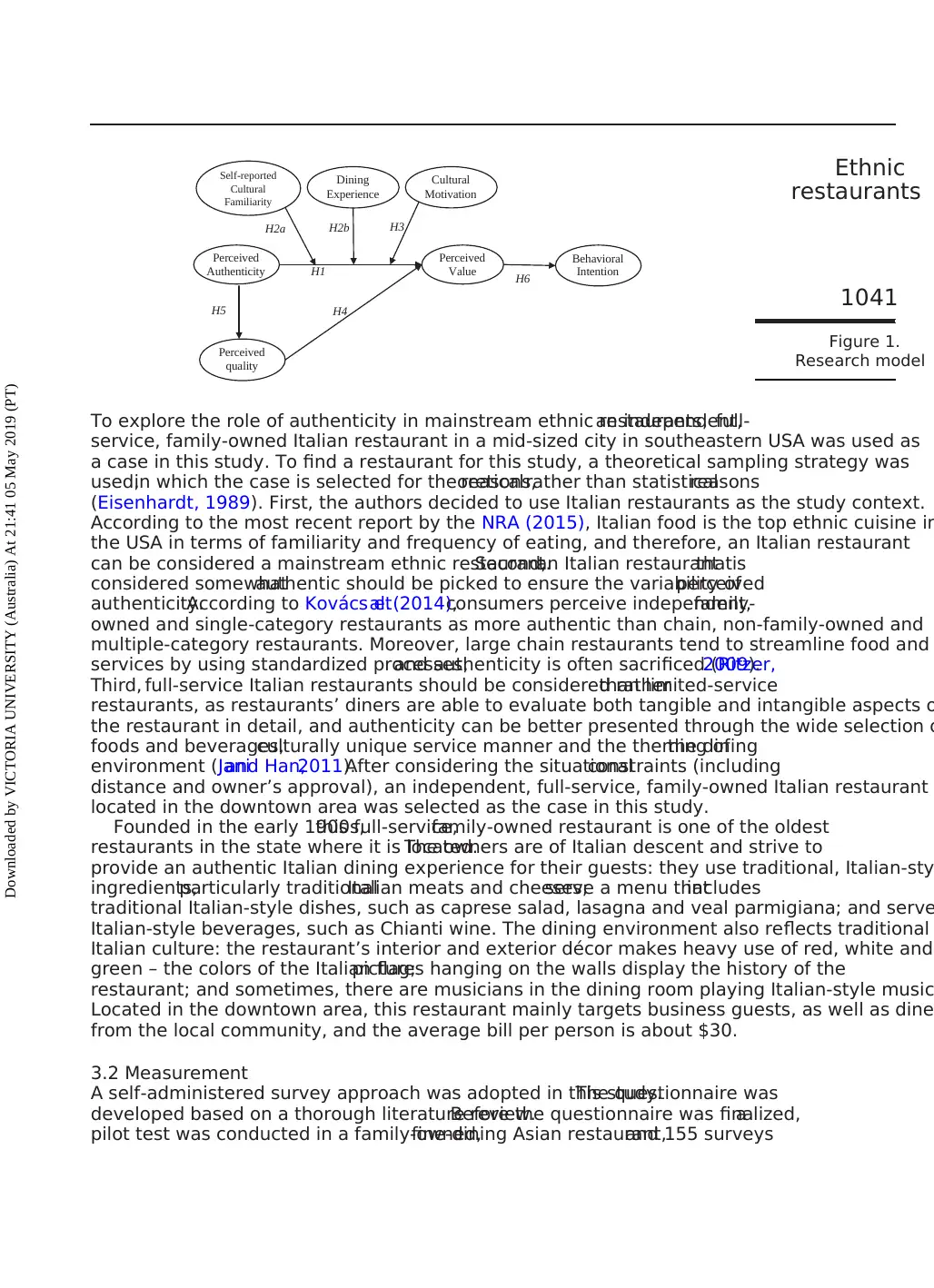
To explore the role of authenticity in mainstream ethnic restaurants,an independent,full-
service, family-owned Italian restaurant in a mid-sized city in southeastern USA was used as
a case in this study. To find a restaurant for this study, a theoretical sampling strategy was
used,in which the case is selected for theoreticalreasons,rather than statisticalreasons
(Eisenhardt, 1989). First, the authors decided to use Italian restaurants as the study context.
According to the most recent report by the NRA (2015), Italian food is the top ethnic cuisine in
the USA in terms of familiarity and frequency of eating, and therefore, an Italian restaurant
can be considered a mainstream ethnic restaurant.Second,an Italian restaurantthatis
considered somewhatauthentic should be picked to ensure the variability ofperceived
authenticity.According to Kovács etal.(2014),consumers perceive independent,family-
owned and single-category restaurants as more authentic than chain, non-family-owned and
multiple-category restaurants. Moreover, large chain restaurants tend to streamline food and
services by using standardized processes,and authenticity is often sacrificed (Ritzer,2009).
Third, full-service Italian restaurants should be considered ratherthan limited-service
restaurants, as restaurants’ diners are able to evaluate both tangible and intangible aspects o
the restaurant in detail, and authenticity can be better presented through the wide selection o
foods and beverages,culturally unique service manner and the theming ofthe dining
environment (Janiand Han,2011).After considering the situationalconstraints (including
distance and owner’s approval), an independent, full-service, family-owned Italian restaurant
located in the downtown area was selected as the case in this study.
Founded in the early 1900s,this full-service,family-owned restaurant is one of the oldest
restaurants in the state where it is located.The owners are of Italian descent and strive to
provide an authentic Italian dining experience for their guests: they use traditional, Italian-sty
ingredients,particularly traditionalItalian meats and cheeses;serve a menu thatincludes
traditional Italian-style dishes, such as caprese salad, lasagna and veal parmigiana; and serve
Italian-style beverages, such as Chianti wine. The dining environment also reflects traditional
Italian culture: the restaurant’s interior and exterior décor makes heavy use of red, white and
green – the colors of the Italian flag;pictures hanging on the walls display the history of the
restaurant; and sometimes, there are musicians in the dining room playing Italian-style music
Located in the downtown area, this restaurant mainly targets business guests, as well as dine
from the local community, and the average bill per person is about $30.
3.2 Measurement
A self-administered survey approach was adopted in this study.The questionnaire was
developed based on a thorough literature review.Before the questionnaire was finalized,a
pilot test was conducted in a family-owned,fine-dining Asian restaurant,and 155 surveys
Figure 1.
Research model
Perceived
Authenticity
Perceived
Value
Self-reported
Cultural
Familiarity
Behavioral
Intention
H6
H1
H4
H2a H3
Perceived
quality
Dining
Experience
Cultural
Motivation
H2b
H5
Ethnic
restaurants
1041
Downloaded by VICTORIA UNIVERSITY (Australia) At 21:41 05 May 2019 (PT)
service, family-owned Italian restaurant in a mid-sized city in southeastern USA was used as
a case in this study. To find a restaurant for this study, a theoretical sampling strategy was
used,in which the case is selected for theoreticalreasons,rather than statisticalreasons
(Eisenhardt, 1989). First, the authors decided to use Italian restaurants as the study context.
According to the most recent report by the NRA (2015), Italian food is the top ethnic cuisine in
the USA in terms of familiarity and frequency of eating, and therefore, an Italian restaurant
can be considered a mainstream ethnic restaurant.Second,an Italian restaurantthatis
considered somewhatauthentic should be picked to ensure the variability ofperceived
authenticity.According to Kovács etal.(2014),consumers perceive independent,family-
owned and single-category restaurants as more authentic than chain, non-family-owned and
multiple-category restaurants. Moreover, large chain restaurants tend to streamline food and
services by using standardized processes,and authenticity is often sacrificed (Ritzer,2009).
Third, full-service Italian restaurants should be considered ratherthan limited-service
restaurants, as restaurants’ diners are able to evaluate both tangible and intangible aspects o
the restaurant in detail, and authenticity can be better presented through the wide selection o
foods and beverages,culturally unique service manner and the theming ofthe dining
environment (Janiand Han,2011).After considering the situationalconstraints (including
distance and owner’s approval), an independent, full-service, family-owned Italian restaurant
located in the downtown area was selected as the case in this study.
Founded in the early 1900s,this full-service,family-owned restaurant is one of the oldest
restaurants in the state where it is located.The owners are of Italian descent and strive to
provide an authentic Italian dining experience for their guests: they use traditional, Italian-sty
ingredients,particularly traditionalItalian meats and cheeses;serve a menu thatincludes
traditional Italian-style dishes, such as caprese salad, lasagna and veal parmigiana; and serve
Italian-style beverages, such as Chianti wine. The dining environment also reflects traditional
Italian culture: the restaurant’s interior and exterior décor makes heavy use of red, white and
green – the colors of the Italian flag;pictures hanging on the walls display the history of the
restaurant; and sometimes, there are musicians in the dining room playing Italian-style music
Located in the downtown area, this restaurant mainly targets business guests, as well as dine
from the local community, and the average bill per person is about $30.
3.2 Measurement
A self-administered survey approach was adopted in this study.The questionnaire was
developed based on a thorough literature review.Before the questionnaire was finalized,a
pilot test was conducted in a family-owned,fine-dining Asian restaurant,and 155 surveys
Figure 1.
Research model
Perceived
Authenticity
Perceived
Value
Self-reported
Cultural
Familiarity
Behavioral
Intention
H6
H1
H4
H2a H3
Perceived
quality
Dining
Experience
Cultural
Motivation
H2b
H5
Ethnic
restaurants
1041
Downloaded by VICTORIA UNIVERSITY (Australia) At 21:41 05 May 2019 (PT)
⊘ This is a preview!⊘
Do you want full access?
Subscribe today to unlock all pages.

Trusted by 1+ million students worldwide
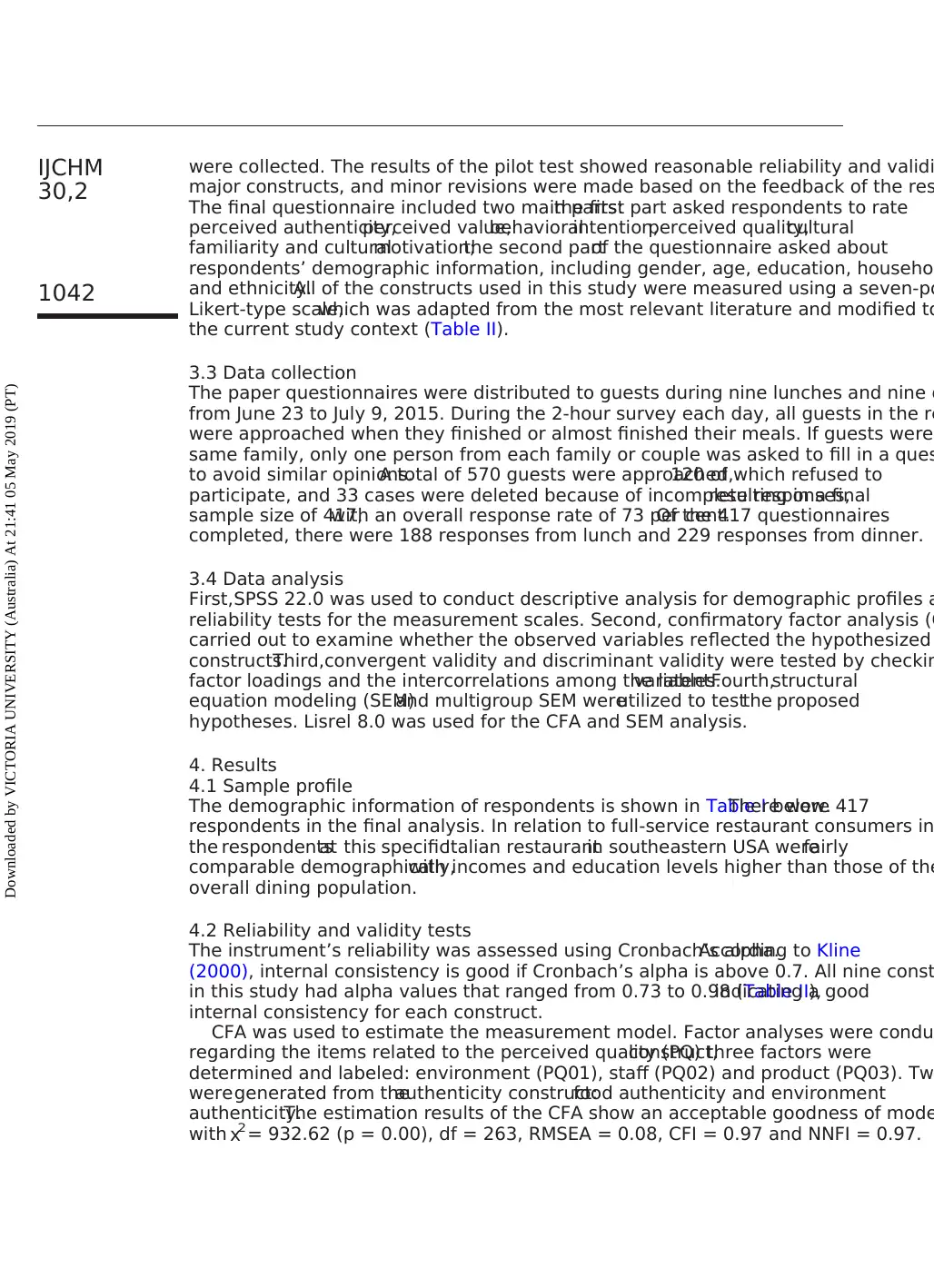
were collected. The results of the pilot test showed reasonable reliability and validi
major constructs, and minor revisions were made based on the feedback of the res
The final questionnaire included two main parts:the first part asked respondents to rate
perceived authenticity,perceived value,behavioralintention,perceived quality,cultural
familiarity and culturalmotivation;the second partof the questionnaire asked about
respondents’ demographic information, including gender, age, education, househol
and ethnicity.All of the constructs used in this study were measured using a seven-po
Likert-type scale,which was adapted from the most relevant literature and modified to
the current study context (Table II).
3.3 Data collection
The paper questionnaires were distributed to guests during nine lunches and nine d
from June 23 to July 9, 2015. During the 2-hour survey each day, all guests in the re
were approached when they finished or almost finished their meals. If guests were
same family, only one person from each family or couple was asked to fill in a ques
to avoid similar opinions.A total of 570 guests were approached,120 of which refused to
participate, and 33 cases were deleted because of incomplete responses,resulting in a final
sample size of 417,with an overall response rate of 73 per cent.Of the 417 questionnaires
completed, there were 188 responses from lunch and 229 responses from dinner.
3.4 Data analysis
First,SPSS 22.0 was used to conduct descriptive analysis for demographic profiles a
reliability tests for the measurement scales. Second, confirmatory factor analysis (C
carried out to examine whether the observed variables reflected the hypothesized
constructs.Third,convergent validity and discriminant validity were tested by checkin
factor loadings and the intercorrelations among the latentvariables.Fourth,structural
equation modeling (SEM)and multigroup SEM wereutilized to testthe proposed
hypotheses. Lisrel 8.0 was used for the CFA and SEM analysis.
4. Results
4.1 Sample profile
The demographic information of respondents is shown in Table I below.There were 417
respondents in the final analysis. In relation to full-service restaurant consumers in
the respondentsat this specificItalian restaurantin southeastern USA werefairly
comparable demographically,with incomes and education levels higher than those of the
overall dining population.
4.2 Reliability and validity tests
The instrument’s reliability was assessed using Cronbach’s alpha.According to Kline
(2000), internal consistency is good if Cronbach’s alpha is above 0.7. All nine const
in this study had alpha values that ranged from 0.73 to 0.98 (Table II),indicating a good
internal consistency for each construct.
CFA was used to estimate the measurement model. Factor analyses were condu
regarding the items related to the perceived quality (PQ)construct,three factors were
determined and labeled: environment (PQ01), staff (PQ02) and product (PQ03). Tw
weregenerated from theauthenticity construct:food authenticity and environment
authenticity.The estimation results of the CFA show an acceptable goodness of mode
with x2= 932.62 (p = 0.00), df = 263, RMSEA = 0.08, CFI = 0.97 and NNFI = 0.97.
IJCHM
30,2
1042
Downloaded by VICTORIA UNIVERSITY (Australia) At 21:41 05 May 2019 (PT)
major constructs, and minor revisions were made based on the feedback of the res
The final questionnaire included two main parts:the first part asked respondents to rate
perceived authenticity,perceived value,behavioralintention,perceived quality,cultural
familiarity and culturalmotivation;the second partof the questionnaire asked about
respondents’ demographic information, including gender, age, education, househol
and ethnicity.All of the constructs used in this study were measured using a seven-po
Likert-type scale,which was adapted from the most relevant literature and modified to
the current study context (Table II).
3.3 Data collection
The paper questionnaires were distributed to guests during nine lunches and nine d
from June 23 to July 9, 2015. During the 2-hour survey each day, all guests in the re
were approached when they finished or almost finished their meals. If guests were
same family, only one person from each family or couple was asked to fill in a ques
to avoid similar opinions.A total of 570 guests were approached,120 of which refused to
participate, and 33 cases were deleted because of incomplete responses,resulting in a final
sample size of 417,with an overall response rate of 73 per cent.Of the 417 questionnaires
completed, there were 188 responses from lunch and 229 responses from dinner.
3.4 Data analysis
First,SPSS 22.0 was used to conduct descriptive analysis for demographic profiles a
reliability tests for the measurement scales. Second, confirmatory factor analysis (C
carried out to examine whether the observed variables reflected the hypothesized
constructs.Third,convergent validity and discriminant validity were tested by checkin
factor loadings and the intercorrelations among the latentvariables.Fourth,structural
equation modeling (SEM)and multigroup SEM wereutilized to testthe proposed
hypotheses. Lisrel 8.0 was used for the CFA and SEM analysis.
4. Results
4.1 Sample profile
The demographic information of respondents is shown in Table I below.There were 417
respondents in the final analysis. In relation to full-service restaurant consumers in
the respondentsat this specificItalian restaurantin southeastern USA werefairly
comparable demographically,with incomes and education levels higher than those of the
overall dining population.
4.2 Reliability and validity tests
The instrument’s reliability was assessed using Cronbach’s alpha.According to Kline
(2000), internal consistency is good if Cronbach’s alpha is above 0.7. All nine const
in this study had alpha values that ranged from 0.73 to 0.98 (Table II),indicating a good
internal consistency for each construct.
CFA was used to estimate the measurement model. Factor analyses were condu
regarding the items related to the perceived quality (PQ)construct,three factors were
determined and labeled: environment (PQ01), staff (PQ02) and product (PQ03). Tw
weregenerated from theauthenticity construct:food authenticity and environment
authenticity.The estimation results of the CFA show an acceptable goodness of mode
with x2= 932.62 (p = 0.00), df = 263, RMSEA = 0.08, CFI = 0.97 and NNFI = 0.97.
IJCHM
30,2
1042
Downloaded by VICTORIA UNIVERSITY (Australia) At 21:41 05 May 2019 (PT)
Paraphrase This Document
Need a fresh take? Get an instant paraphrase of this document with our AI Paraphraser
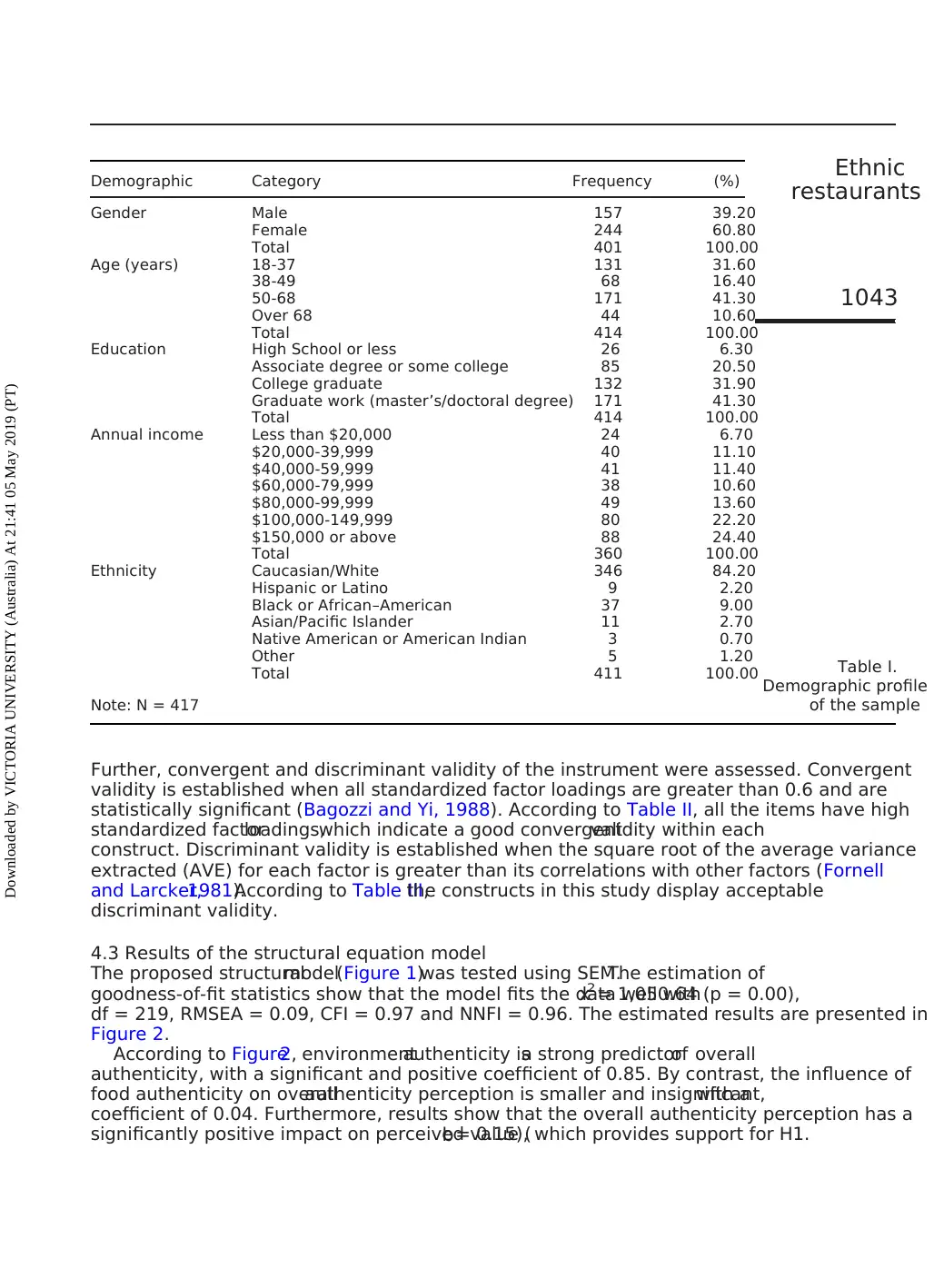
Further, convergent and discriminant validity of the instrument were assessed. Convergent
validity is established when all standardized factor loadings are greater than 0.6 and are
statistically significant (Bagozzi and Yi, 1988). According to Table II, all the items have high
standardized factorloadings,which indicate a good convergentvalidity within each
construct. Discriminant validity is established when the square root of the average variance
extracted (AVE) for each factor is greater than its correlations with other factors (Fornell
and Larcker,1981).According to Table III,the constructs in this study display acceptable
discriminant validity.
4.3 Results of the structural equation model
The proposed structuralmodel(Figure 1)was tested using SEM.The estimation of
goodness-of-fit statistics show that the model fits the data well withx2 = 1,050.64 (p = 0.00),
df = 219, RMSEA = 0.09, CFI = 0.97 and NNFI = 0.96. The estimated results are presented in
Figure 2.
According to Figure2, environmentauthenticity isa strong predictorof overall
authenticity, with a significant and positive coefficient of 0.85. By contrast, the influence of
food authenticity on overallauthenticity perception is smaller and insignificant,with a
coefficient of 0.04. Furthermore, results show that the overall authenticity perception has a
significantly positive impact on perceived value (b= 0.15), which provides support for H1.
Table I.
Demographic profile
of the sample
Demographic Category Frequency (%)
Gender Male 157 39.20
Female 244 60.80
Total 401 100.00
Age (years) 18-37 131 31.60
38-49 68 16.40
50-68 171 41.30
Over 68 44 10.60
Total 414 100.00
Education High School or less 26 6.30
Associate degree or some college 85 20.50
College graduate 132 31.90
Graduate work (master’s/doctoral degree) 171 41.30
Total 414 100.00
Annual income Less than $20,000 24 6.70
$20,000-39,999 40 11.10
$40,000-59,999 41 11.40
$60,000-79,999 38 10.60
$80,000-99,999 49 13.60
$100,000-149,999 80 22.20
$150,000 or above 88 24.40
Total 360 100.00
Ethnicity Caucasian/White 346 84.20
Hispanic or Latino 9 2.20
Black or African–American 37 9.00
Asian/Pacific Islander 11 2.70
Native American or American Indian 3 0.70
Other 5 1.20
Total 411 100.00
Note: N = 417
Ethnic
restaurants
1043
Downloaded by VICTORIA UNIVERSITY (Australia) At 21:41 05 May 2019 (PT)
validity is established when all standardized factor loadings are greater than 0.6 and are
statistically significant (Bagozzi and Yi, 1988). According to Table II, all the items have high
standardized factorloadings,which indicate a good convergentvalidity within each
construct. Discriminant validity is established when the square root of the average variance
extracted (AVE) for each factor is greater than its correlations with other factors (Fornell
and Larcker,1981).According to Table III,the constructs in this study display acceptable
discriminant validity.
4.3 Results of the structural equation model
The proposed structuralmodel(Figure 1)was tested using SEM.The estimation of
goodness-of-fit statistics show that the model fits the data well withx2 = 1,050.64 (p = 0.00),
df = 219, RMSEA = 0.09, CFI = 0.97 and NNFI = 0.96. The estimated results are presented in
Figure 2.
According to Figure2, environmentauthenticity isa strong predictorof overall
authenticity, with a significant and positive coefficient of 0.85. By contrast, the influence of
food authenticity on overallauthenticity perception is smaller and insignificant,with a
coefficient of 0.04. Furthermore, results show that the overall authenticity perception has a
significantly positive impact on perceived value (b= 0.15), which provides support for H1.
Table I.
Demographic profile
of the sample
Demographic Category Frequency (%)
Gender Male 157 39.20
Female 244 60.80
Total 401 100.00
Age (years) 18-37 131 31.60
38-49 68 16.40
50-68 171 41.30
Over 68 44 10.60
Total 414 100.00
Education High School or less 26 6.30
Associate degree or some college 85 20.50
College graduate 132 31.90
Graduate work (master’s/doctoral degree) 171 41.30
Total 414 100.00
Annual income Less than $20,000 24 6.70
$20,000-39,999 40 11.10
$40,000-59,999 41 11.40
$60,000-79,999 38 10.60
$80,000-99,999 49 13.60
$100,000-149,999 80 22.20
$150,000 or above 88 24.40
Total 360 100.00
Ethnicity Caucasian/White 346 84.20
Hispanic or Latino 9 2.20
Black or African–American 37 9.00
Asian/Pacific Islander 11 2.70
Native American or American Indian 3 0.70
Other 5 1.20
Total 411 100.00
Note: N = 417
Ethnic
restaurants
1043
Downloaded by VICTORIA UNIVERSITY (Australia) At 21:41 05 May 2019 (PT)
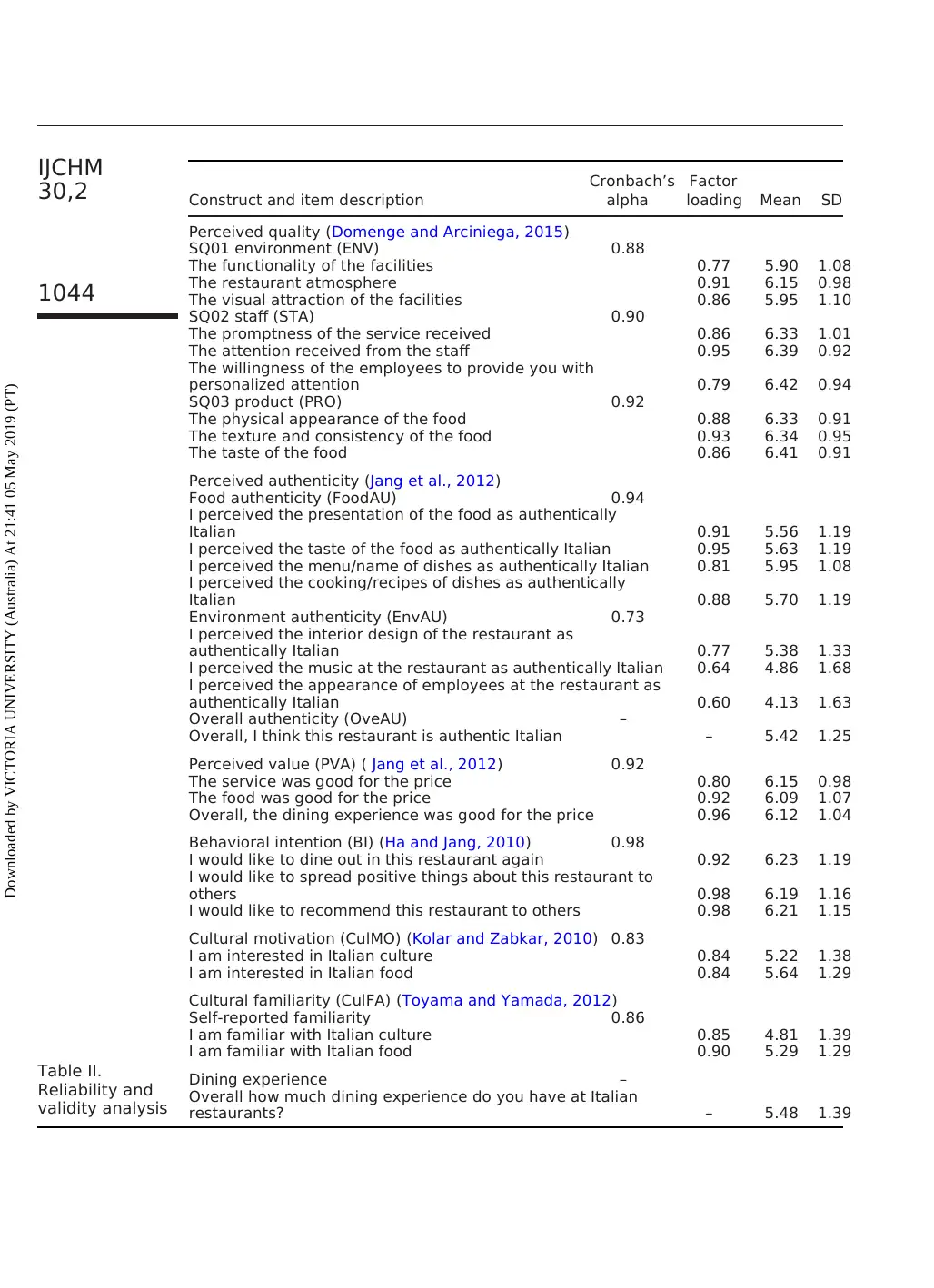
Table II.
Reliability and
validity analysis
Construct and item description
Cronbach’s
alpha
Factor
loading Mean SD
Perceived quality (Domenge and Arciniega, 2015)
SQ01 environment (ENV) 0.88
The functionality of the facilities 0.77 5.90 1.08
The restaurant atmosphere 0.91 6.15 0.98
The visual attraction of the facilities 0.86 5.95 1.10
SQ02 staff (STA) 0.90
The promptness of the service received 0.86 6.33 1.01
The attention received from the staff 0.95 6.39 0.92
The willingness of the employees to provide you with
personalized attention 0.79 6.42 0.94
SQ03 product (PRO) 0.92
The physical appearance of the food 0.88 6.33 0.91
The texture and consistency of the food 0.93 6.34 0.95
The taste of the food 0.86 6.41 0.91
Perceived authenticity (Jang et al., 2012)
Food authenticity (FoodAU) 0.94
I perceived the presentation of the food as authentically
Italian 0.91 5.56 1.19
I perceived the taste of the food as authentically Italian 0.95 5.63 1.19
I perceived the menu/name of dishes as authentically Italian 0.81 5.95 1.08
I perceived the cooking/recipes of dishes as authentically
Italian 0.88 5.70 1.19
Environment authenticity (EnvAU) 0.73
I perceived the interior design of the restaurant as
authentically Italian 0.77 5.38 1.33
I perceived the music at the restaurant as authentically Italian 0.64 4.86 1.68
I perceived the appearance of employees at the restaurant as
authentically Italian 0.60 4.13 1.63
Overall authenticity (OveAU) –
Overall, I think this restaurant is authentic Italian – 5.42 1.25
Perceived value (PVA) ( Jang et al., 2012) 0.92
The service was good for the price 0.80 6.15 0.98
The food was good for the price 0.92 6.09 1.07
Overall, the dining experience was good for the price 0.96 6.12 1.04
Behavioral intention (BI) (Ha and Jang, 2010) 0.98
I would like to dine out in this restaurant again 0.92 6.23 1.19
I would like to spread positive things about this restaurant to
others 0.98 6.19 1.16
I would like to recommend this restaurant to others 0.98 6.21 1.15
Cultural motivation (CulMO) (Kolar and Zabkar, 2010) 0.83
I am interested in Italian culture 0.84 5.22 1.38
I am interested in Italian food 0.84 5.64 1.29
Cultural familiarity (CulFA) (Toyama and Yamada, 2012)
Self-reported familiarity 0.86
I am familiar with Italian culture 0.85 4.81 1.39
I am familiar with Italian food 0.90 5.29 1.29
Dining experience –
Overall how much dining experience do you have at Italian
restaurants? – 5.48 1.39
IJCHM
30,2
1044
Downloaded by VICTORIA UNIVERSITY (Australia) At 21:41 05 May 2019 (PT)
Reliability and
validity analysis
Construct and item description
Cronbach’s
alpha
Factor
loading Mean SD
Perceived quality (Domenge and Arciniega, 2015)
SQ01 environment (ENV) 0.88
The functionality of the facilities 0.77 5.90 1.08
The restaurant atmosphere 0.91 6.15 0.98
The visual attraction of the facilities 0.86 5.95 1.10
SQ02 staff (STA) 0.90
The promptness of the service received 0.86 6.33 1.01
The attention received from the staff 0.95 6.39 0.92
The willingness of the employees to provide you with
personalized attention 0.79 6.42 0.94
SQ03 product (PRO) 0.92
The physical appearance of the food 0.88 6.33 0.91
The texture and consistency of the food 0.93 6.34 0.95
The taste of the food 0.86 6.41 0.91
Perceived authenticity (Jang et al., 2012)
Food authenticity (FoodAU) 0.94
I perceived the presentation of the food as authentically
Italian 0.91 5.56 1.19
I perceived the taste of the food as authentically Italian 0.95 5.63 1.19
I perceived the menu/name of dishes as authentically Italian 0.81 5.95 1.08
I perceived the cooking/recipes of dishes as authentically
Italian 0.88 5.70 1.19
Environment authenticity (EnvAU) 0.73
I perceived the interior design of the restaurant as
authentically Italian 0.77 5.38 1.33
I perceived the music at the restaurant as authentically Italian 0.64 4.86 1.68
I perceived the appearance of employees at the restaurant as
authentically Italian 0.60 4.13 1.63
Overall authenticity (OveAU) –
Overall, I think this restaurant is authentic Italian – 5.42 1.25
Perceived value (PVA) ( Jang et al., 2012) 0.92
The service was good for the price 0.80 6.15 0.98
The food was good for the price 0.92 6.09 1.07
Overall, the dining experience was good for the price 0.96 6.12 1.04
Behavioral intention (BI) (Ha and Jang, 2010) 0.98
I would like to dine out in this restaurant again 0.92 6.23 1.19
I would like to spread positive things about this restaurant to
others 0.98 6.19 1.16
I would like to recommend this restaurant to others 0.98 6.21 1.15
Cultural motivation (CulMO) (Kolar and Zabkar, 2010) 0.83
I am interested in Italian culture 0.84 5.22 1.38
I am interested in Italian food 0.84 5.64 1.29
Cultural familiarity (CulFA) (Toyama and Yamada, 2012)
Self-reported familiarity 0.86
I am familiar with Italian culture 0.85 4.81 1.39
I am familiar with Italian food 0.90 5.29 1.29
Dining experience –
Overall how much dining experience do you have at Italian
restaurants? – 5.48 1.39
IJCHM
30,2
1044
Downloaded by VICTORIA UNIVERSITY (Australia) At 21:41 05 May 2019 (PT)
⊘ This is a preview!⊘
Do you want full access?
Subscribe today to unlock all pages.

Trusted by 1+ million students worldwide
1 out of 21
Your All-in-One AI-Powered Toolkit for Academic Success.
+13062052269
info@desklib.com
Available 24*7 on WhatsApp / Email
![[object Object]](/_next/static/media/star-bottom.7253800d.svg)
Unlock your academic potential
Copyright © 2020–2025 A2Z Services. All Rights Reserved. Developed and managed by ZUCOL.
